glacieresnationalpark
26-31 Jan 2015 – Bye Bye Bolivia, sea-sized Lake Titicaca & hello Peru!

Leaving La Paz wasn’t the cruisey ride I’d pictured. To begin with, we had some heartfelt farewells and heartwarming moto-hugs to dispense. Oscar reluctantly let us go and sent us on our merry way into the bedlam of downtown La Paz. Getting out of the city meant getting well and truly stuck in it first. Busy with barminess, I hovered over and hit my horn like I was signaling Morse code: ‘Get-me-out-of-here!’ A veritable racket and tantamount to ten times the danger of Bolivia’s disreputable Death Road. Sandwiched between Toyota Town-Aces and Hi-Aces, my panniers scraped and scratched like nobody’s business. A fit of fury stuck halfway down my throat, like a sneeze that refused to come. Mind unraveling to become somewhat discombobulated, I gritted my teeth and remained undeterred, at least outwardly.
Two and a quarter hours we trawled through rush hour in air that was oppressive, thick and full of menace. “Che boludo!”, I may’ve mouthed when drivers in their moving metal boxes pressed in; a derogatory term relating to the perpetrator’s derrière. “Breathe in Pearl”, I urged, “The nutters are out!” as sweat matted my riding top and motorcycle trousers to my arms and legs. I fidgeted like a toad leg frying in hot oil. Intermittently crawling through the city’s sprawl at a snail’s pace in between going hell for leather surfaced my inner-anarchist. Pearl was screaming out for idiot-protection bars like a four-wheel drive needs ‘roo bars in Australia’s bush. It was maddening as it was toilsome, I might as well have been treading in a flood of biting ants.
Would I miss the futile sense of urgency from drivers? – pipping in frantic haste whose clanging disorder and toxic fumes billowed around us – feeling the mixture wrap around my face like a hot bandage. The mishmash of concentrated blockhouses, built to look like a bland, Lego city and climbing up the rocky mesas like poison ivy. Or the trash-lined roads patrolled by snarling dogs that raced alongside us like whipped curs. That is, until becoming burnt out and bungled by malevolent forces – its guts slithered out like wet eels, sliding from a slit sack. The answer is probably not, cities are not ordinarily my thing. Sometimes the happiness of one end of a city can soon sour at the other. Jason was getting travel-weary of coursing through city after city; it was high time to leave them alone for a while.

Having finally escaped the brunt of La Paz’s stinging bite of traffic, an unforeseen reward for the morning’s calamity unfolded as we cruised towards Copacabana. Through a smog-blackened face, my eyes darted over rolling swells of green countryside on a stunning road. I smiled every mile past the traditional Aymará villages to the glacier-capped, brilliant white snowy peaks of the Cordillera Real. And then our eyes gravitated like magnets on the singularity of Lake Titicaca, its energy and sheer gravity drawing us in. Crystalline, gemlike water sparkled in a clear, Altiplano light. ‘Pretty special alright’, my radar registered.

No sooner had we kicked the side-stands down at San Pedro de Tiquina and the pair of us dived into the local catch. What felt like eating our head weight in fried white bait and trucha – trout, was a stomach-gratifying, taste sensation. That is, until the signal hit my brain I was more than full on fish. But what a welcomed interruption from meat.
Hopping across the water on a makeshift craft that resembled a rickety raft more than a sturdy boat was a rigmarole in itself, negotiating two heavy bikes aboard. The boat cleaved gently through turquoise waters until we spilled onto the shoreline. There we continued on ruta 2’s snaking ribbon of highway all the way to Copacabana – affording one of the best views of the vast expanse of blue. Biking bliss after the morning’s manic encounter with moronic drivers.

The world’s highest navigable body of water, Lake Titicaca is gar-gantuan. It goes on and on, way beyond the eye can see. A watery world without end. Set between Peru and Bolivia, the 8,400 square kilometre mass of shimmering freshwater is more akin to a sea than a lake. It’s no wonder history reveals how Inca legends and Andean beliefs came to credit Lake Titicaca with the birthplace of their civilization and the sun, connecting it to mystical events. There was a discernibly calm, soothing energy about the place.
Nestled between two hills and perched on the southern shore of the lake, Copacabana was a small, tourist-centric town, apparently still attracting international pilgrims who flock to its fiestas. We took flight after an overnight stay at Hostel Sonia having had our fill of Bolivia and pushed onto Peru.
Through Andean countryside dotted with villages, high-altitude hamlets and ruins all linked by ancient Inca culture, we sailed past terrace-lined foothills and mountainside. How had people once worked the land so industriously, so uniformly in linear lines – so high up? With women wearing petticoats and moccasins made from used tyres, still working the land by hand, it felt Peruvian all at once, rich in its Inca heritage.
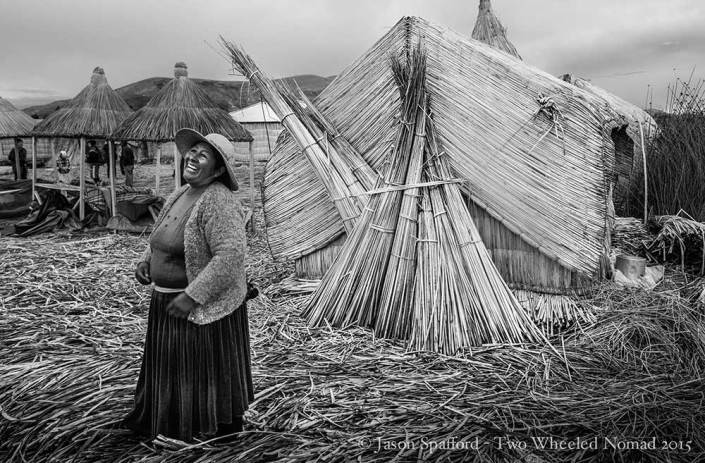
Just 7 kilometres east of our accommodation, Hostel Uros in Puno, we took ourselves off to see some floating islands. Utterly unique because they’ve been constructed from nothing; created entirely with the buoyant totora reeds that grow abundantly in the shallows of Lake Titicaca. The lives of the Aymará speaking Uros islanders are intertwined with the reeds. Edible in part, they also build their homes, transport, arts and whimsical crafts from the versatile material. Walking on the island was as soft and springy as a freshly baked cake. Their unusual floating existence roots back to an effort to avoid and isolate themselves from the aggressive Collas and Incas tribes. A peaceful people.

I was greeted by five families, all of whom displayed boundless personality. Although in tune with a tourist-ready set up, a set of folkloric songs were sung in dulcet tones of Aymará as well as a distant version of English. In such a contemporary age, I enjoyed seeing this time-honoured way of living for myself. Even if I did get further collared to pay for an obligatory reed-boat ride, powered by an engine attached to an adjoining smaller boat, and encouraged to buy handmade goods I was neither inclined to purchase nor wanted to carry on my motorcycle. These good folks needed to stay afloat like anyone else.
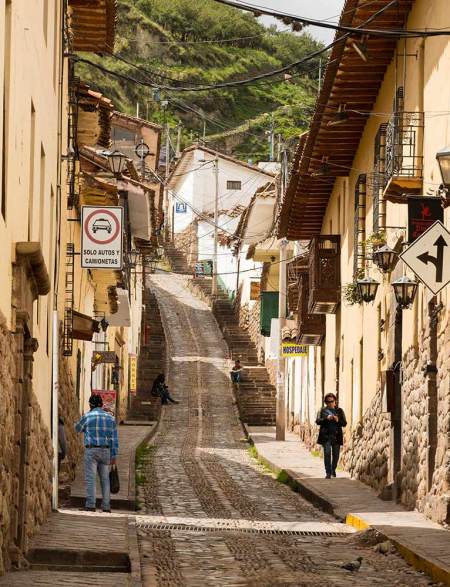
Cusco told me in ten minutes it would rank my favourite South American city to date. Rough-hewn cobble stoned, steep narrow streets, lined by meticulously crafted masonry and a bright, feel-safe city ambiance pervaded throughout. It was a superb collision of chaotic and modern with slow and traditional. Estrellita Hostel was an ideal spot for the bikes and us, closely located to the heart of the old-fashioned city. I cared little and less that the place was packed with massage hawkers, a glut of tourist ware-touting locals hunting you like prey amid a minefield of Machupicchu tour operators, the place was throbbing with life. The fare was excellent, especially the fresh cuisine at Jack’s Café and Korma Sutra. It was ‘vista fantastic’ with no shortage of intriguing vantage points. I could’ve sat people watching all day.
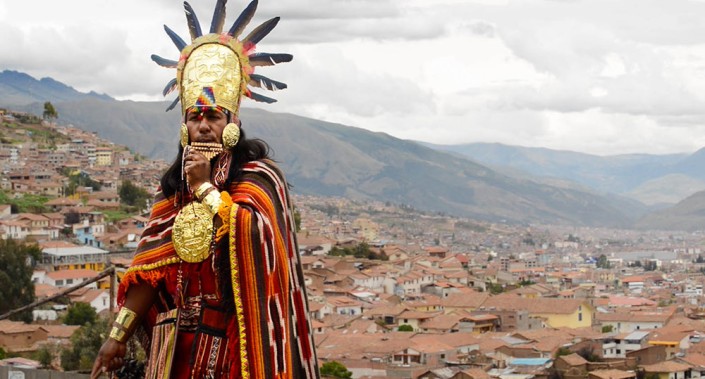

Fiestas occur at frequent intervals in Cusco and one night we meandered through a firework-lit celebration in honour of the church. Live festival-inspired music permeated our ears as I squeezed my way in between the carnival market vendors offering supersized pale corn-on-the-cob with cheese alongside chicha morada, which is a sweet Peruvian beverage made from purple corn, roasted guinea pig or alpaca. I soon became an inveterate fan to the cactus flower fruit, which was fuchsia pink and finger-licking good. In fact, Peru’s roads were full of the flowering fruits – bush food ripe for the picking and packed with a sweetened punch. It developed into the perfect roadside snack and our jam-sandwich breakfast substitute. People jostled past coming and going in the teeming streets; the place was alive with a street dancing atmosphere.

Courtesy of social media, we’d become acquainted with Andrew – a loquacious Brit with a passion for night skies, skippering boats and photography – who’d been living in Cusco for the last seven years. After three too many dark beers, we spotted a local singer being filmed half way up a scenic street. Jupiter’s moons were illuminating the sky and the singer’s crescent shape line of groupies were evidently enjoying the show. The situation fostered an odd behaviour. In the heat of a spontaneous second, I found myself shamelessly dancing with this cheesetastic grinning guy; perhaps not one of my classiest moments gatecrashing his gig! Still, the crowd eddied and purled around me, cheering with full encouragement exclaiming that I’d be sure to feature on Peruvian television. I haven’t the slightest inkling why doing that seemed a good idea at the time.
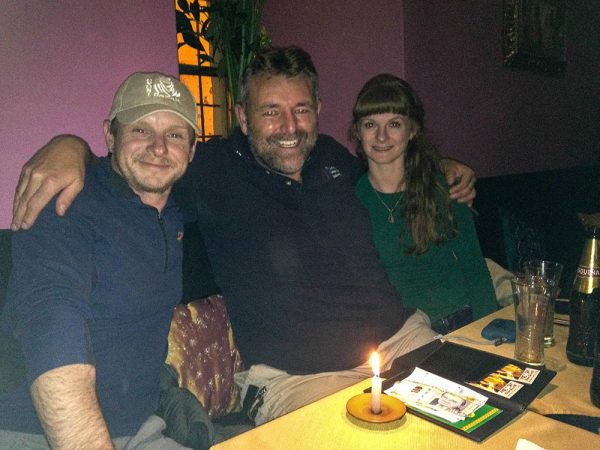

All walks of life can be found in Cusco, not just the holidaymakers, travellers, honorary locals and residents. A Peruvian woman, well into the winter of her days, sat kind of crouched over on the floor. In the middle of a busy backstreet. She may’ve fallen, dropped something or stooped to pick up something she’d found perhaps. “Are you alright lady? Can I help at all?”, I enquired in survival Spanish. Stumbling over the language I kept probing, like a tongue returning to an abscess. She looked at me a little strained and shook her head. I think I was walking on ground uninvited. Curious, I thought. Or not. I looked at a metre radius around the woman and the full force of recognition hit me. My quagmire was her irredeemable, sticky situation. This lady was patently and simply having a nice, big number two! I can’t speak with specificity about this lady’s choice of location but oh my, there’s a memory of Cusco that’ll never fade.


25 Jan 2015 – The Road of Death on motorcycle
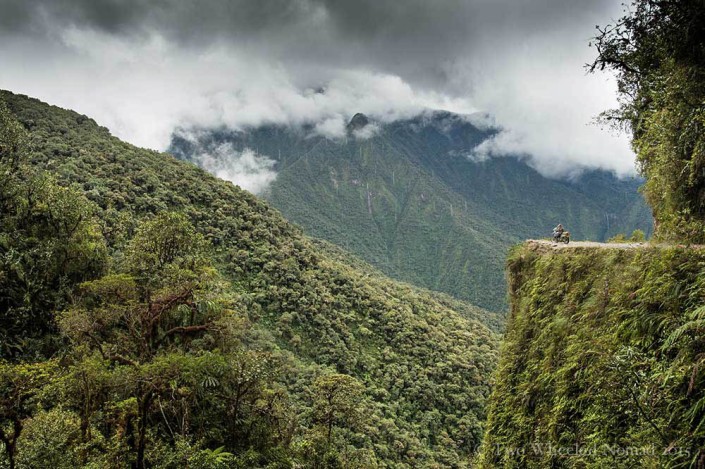
An 11,000-foot descent, sheer drops and 200 plus deaths a year: Welcome to Bolivia’s Road of Death, the terrifying route tourists love to two wheel down. Its official name is Camino a las Yungas but it’s best known as La Carretera de la Muerte, the Road of Death. It’s not just a name either: the gorgeously lush, winding 64-kilometre route that links La Paz with the town of Coroico was and is still considered one of the deadliest roads in the world. Just one of many in Bolivia.
The North Yungas journey is renowned to be overwhelming, as much for the staggering scenery as for the dangerous gravel route. Part of the transition zone where the Andes fall away into the Amazon Basin. For the locals, the ‘Death Road’ was an important transport route, which they braved in cars and trucks, teetering on the edge and risking their lives with every trip. The mortality rate is not surprising considering that: safety barriers are few and far between, vehicles meet head on along a miniscule dirt track – at peak altitudes of more than 4,500 metres – and with a vicious drop off on one side of up to 800 metres. No wonder it was deemed ‘The world’s most dangerous road’ by an Inter-American Development Bank report in 1995. On the up side there’s now a much improved, replacement route, which since 2007 tends to all the heavies and commuter traffic with far less incident than before. Still, leaving an old road not to be reckoned with.
Although still in use by the odd local car, tourist minibus and support vehicle, it’s the over-zealous cyclists that come a cropper, more than passing motorised traffic. This is because of kamikaze, freewheeling cycle guides racing down at full tilt for the sheer thrill, substandard mountain bikes on hire to one and all, or a blind unawareness if not overconfidence to any oncoming, upward traffic.

Psyched with a mixed bag feeling of ‘Just how hard is this road going to be?’ deliciously tinged with that pre-excitement you get moments before a rollercoaster’s tipping point. We gave ourselves no choice but to take a deep breath and carefully: navigate around careening cyclists hell bent on fulfilling their bragging rights, falling rocks and blind hairpin bends, penetrate waterfalls, cross two rivers and endure the fog, mud and humidity. All over a 3,600 metre vertical descent. We knew the trip was set to take in stunning views among the rolling hills, but come with the somewhat distracting – and for some frightening – lofty heights from the canopy as two rubber tyres separate the rider from a narrow single-lane road with very little in the way of roadside protection. The ride was set to be adrenaline-packed as it was unforgettable.
Built on the backbreaking labours of Paraguayan prisoners during the Chaco War between Bolivia and Paraguay, the construction of the road took place in the 1930s. Due to both the engineering design of that decade and the natural structure of the area, its topography and geological formation meant steep slopes were created. The resultant single-track lane varied in width from 2.9 to 3.5 metres.
Our starting point in La Paz at 3,600 metres was almost a low point compared to the motorcycle-chugging ascent up to La Cumbre’s cloud forest at 4,650 metres. Along the way on ruta 3, I coaxed Pearl on a little as she sighed in a sluggish, less responsive manner. ‘It’s alright lady, I’ll keep you in third gear’, I reassured her. We fumbled our way farther on through bike-swallowing fog under grey scraps of cloud, which tossed like leaves in a fitful breeze, shifted, like wind-tossed foliage. The cold wind helped to numb the pangs of hunger but didn’t alleviate my desperation for a pee; it pushed against my bladder like a pin piercing my belly.
With my visor permanently steamed up, icy rain pellets stung my cheeks as I carefully worked my way up and down the undulations of the road, skirting around deceptively deep potholes. I probably looked like a drunken sailor on two wheels heading toward the next watering hole. When you face the force of foggy rain, you don’t exactly ride boldly forward in a show of unbridled confidence. Bluster will get you battered. Still, the views passing Cotapata National Park took on the supremacy of the Scottish highlands, the delirium of England’s Lake District and then New Zealand’s soul-nourishing hills, towering above us. Bolivia for me just keeps getting better and better.
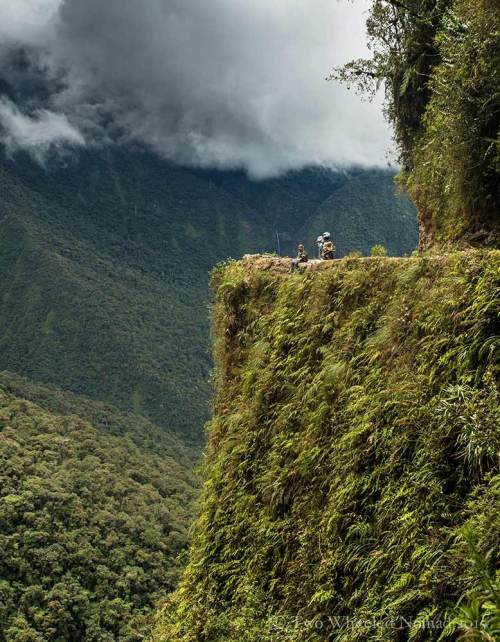 The entrance to the Death Road started in rarefied air, slightly above the already high-elevation of La Paz. Although not so deadly nowadays, for a few hummingbird heartbeats the realisation of making one mistake and you’d meet your maker hit home, but the thought flickered away again. May be the thought of reaching ‘game over’ had been lurking but I hadn’t dared to admit it because then, like the nuclear bomb, it could never be uninvented. Pearl and I would exercise care and become caution personified.
The entrance to the Death Road started in rarefied air, slightly above the already high-elevation of La Paz. Although not so deadly nowadays, for a few hummingbird heartbeats the realisation of making one mistake and you’d meet your maker hit home, but the thought flickered away again. May be the thought of reaching ‘game over’ had been lurking but I hadn’t dared to admit it because then, like the nuclear bomb, it could never be uninvented. Pearl and I would exercise care and become caution personified.
Before biting the bullet onto the road itself, we spotted a pair of 250cc Chinese bikes in a clearing and, perhaps stalling for a little time, headed straight for them. Two Australian guys were also preparing for the thrill ride, getting their gig in order as much mentally as physically. Their jacket-less armour and lightweight machines boasting proper knobblies made quite the model ‘Death Road’ ensemble. “Nice bikes, guys!” was the first comment to come from them. “Thanks lads, looking forward to the Death Road?” I enquired. Of course, now lets go do it.
The mix of beauty and danger on the Death Road was intoxicating. The stony dirt track thinned and when it nearly died altogether, grew more confident just as quickly, giving way to a wider track, which led to a stretch so to speak, rideable on road. Without wisdom, imagination is a cruel taskmaster. I observed early on that letting go of any alleviated gnaw of anxiety, got us moving much quicker.
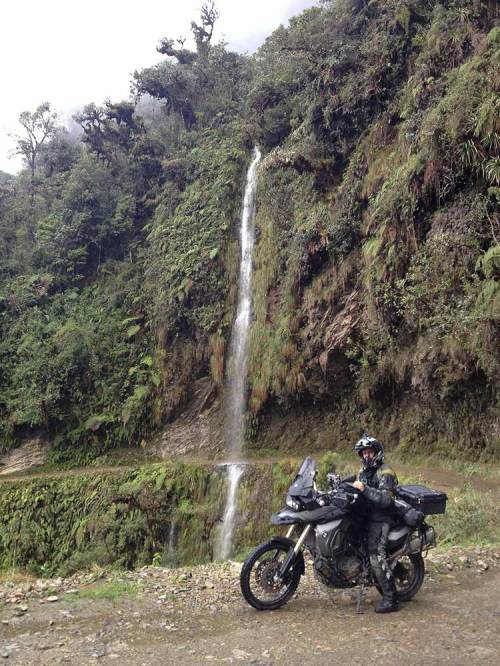
Despite the intermittent bounteous rainfall, repeatedly stopping to don and ditch the waterproof onesies, the weight of the world dissolved in the invigorating flashes of the rainbow-spraying waterfalls, the sun on my shoulders and the stillness of the place drawing me in. With the remnants of the cyclists remaining after midday – who waved their fronds and gave way to us – an excitement sang in my veins as I rode along the steep and bumpy track. It seemed the whole world was in my grasp, and it seemed as though I was lifting off above myself; tooling along on my Pearl and at the same time lifting into the sky, and so filled with elation and freedom that I had to open my mouth and scream.

Jason was itching like a kid on Christmas morning to unwrap the quadcopter from its box and take it for a spin over the near-vertical abyss. The space between the dry highlands’ Altiplano-bound clouds and the steaming, forested depths of the humid lowlands. I guess it’s every drone pilot’s dream to capture the airborne essence of such a dramatic scene. Alas, the pervading air of hard-won tranquility ceased and resulted in a rather calamity-led crash. Inches away from plummeting over the precipice, the unit dropped towards us like a gannet dive-bombing its prey. That high thin air left little and less for the drone to push against. Hey ho, Jason had still managed to shoot a few microseconds of aerial gold.
Hugging the walls of the sheer valley, we snaked our way beneath rocky overhangs and elongated cascades. It’s impossible to ignore the reminders of fatalities as we rode past shrines, memorials and crosses that pop up at chillingly frequent intervals. All marking the tragedy of the vast number of lives lost to the road. It humbled me from the inside out.
High in lush elevated jungle, riding through 100-meter high waterfalls, streams and by coca fields was a ride like no other. As I got power-showered through the waterfalls, the terrain became its most rocky. And slippery, washing away part of the road. I rallied. I had better go through with it, Pearl had pride. More than me. It was easier than I’d anticipated, as if I were an oyster already loosened within the shell. I held onto the little thrill this gave me. A needlelike pleasure in my stomach, just below my ribcage.

Close to the road’s connecting town of Coroico – a town that takes its name from the Quechua word coryguayco meaning ‘golden hill’ – we convened at the second river crossing. More rocky than the former river’s pebbly version, the latter was also longer; a 20-metre stream gushing water half way up our wheels as we wended through. Two locals had parked up in a shallower section, utilsing the free resource to clean their cars and themselves. Why not? The water looked fresh and sparkling, pure enough to drink I’d imagine. I staggered across on Pearl, a little jerky as Jason effortlessly glided through showing me how it was done. My textbook river crossing would have to wait.
We survived all the way to the end of the Death Road. Its steep mountains, plunging valleys and rugged terrain. Whoa! It seemed only logical to return the way we came and enjoy the road going back up. Even if it meant meeting the odd unsuspecting cyclist or car coming downhill; as oncoming upward traffic, we supposedly had right of way. Ascending was in fact easier, enjoying the physical and psychologically safer wall of the mountainside on my left. One of the few if not only places in South America that stipulates left-hand side driving.
The afternoon’s momentum maintained in full swing, showers fell on and off until eventually the sky dried and reared up above us, rose and lavender. The reverse journey saw long shadows inch across the dense, bottle green sub-tropical Yungas. There was a light from the sky that gilded the clouds, intensifying the sun lowering every hour. Definitely a day to let the world take care of itself, a paradise of thoughtfulness.

The Camino de la Muerte is a legendary road and despite its past innumerable deaths experienced, that moment of adrenaline, suspense to the unknown and exposure to nature, you can feel the fascination and buzz – down and up. Every second that passed the little hairs on the back of my neck rose, whilst my image-tank became full to bursting as emerging and radiant growth unfurled before us. It was a biker’s fantasy with jaw-on-the-floor views, another visceral experience. It left me windblown, mind blown and exhilarated.

13-24 Jan 2015 – Leaving footprints in Torotoro & a present from La Paz

With the misadventure of missing the Dakar from Salar de Uyuni having passed, we wished the moto Olympians well for the remainder of the race (from afar), and scampered back to Sucre with a tail between our legs. Refuelled and rested in Bolivia’s constitutionally recognised capital, we scurried the 200 odd miles over rutas 5, 23 and 7 leading us into the urban sprawl that is Cochambamba. The streets were saturated with photocopier shops, crammed in between kiosks bursting with processed junk, chips and salsa, banks of candy and great walls of electrified soda.
Hotels and motels straggled over the city were also bountiful, budget-traveller hostels not so much. We stumbled upon a little serendipity tucked away down Junin street, Hostel Casa Vieje Colonial. It didn’t burn a hole in our pockets to: securely park the bikes with easy access, relax the weary muscles in a hot shower or store our stuff to take a two-day trip to Torotoro National Park. Perfecto.

The drive to Torotoro was akin to the Wizard of Oz’s yellow brick road, except it was bobbly and rough-hewn as opposed to uniformly bricked and a radiant hue of yellow. Rugged road became narrower in parts, windier single track lane became packed earth peppered with knobbly, bone-like flints. The snaking, slapdash cobblestones glistened in the wet. Parts of the road were slick with mud, hindered by the odd land slide and broken by flooded river crossings. No wonder it took four bum-jolting hours to do 80 miles, even in our hired four-wheel drive. The same cobblestone-fashioned road made a sizeable appearance en route to Cochambamba, making it slippery under foot and an ice-rink for two wheels. In Bolivia’s wettest month of the year, it took a thimble of sense to catch a four-wheeled ride over to Torotoro.

Home to mineral-rich canyons and cavern-filled caves, blind fish and a turtle cemetery, our sole impetus for seeing Torotoro National Park was to witness 65 million years of natural history. Dinosaur footprints! Clearly imprinted in the petrified clay, some were the size and depth of footballs, others more precise leaving a three-clawed impression. There were thousands of depressions, dotted around so you could follow their trail; trace where the owners had once chased one another, sauntered around or stomped away somewhere. As far as paleontology goes, it piqued my interest more than any museum glass-housed fossil.
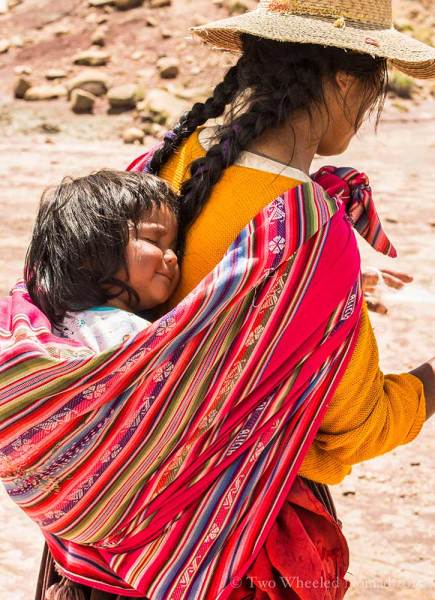
Deep into folds of the National Park we followed our mountain-goat guide, Timo, pulled along in his wake. At the furthest point on we met Elminia, carrying her 18 month old son Hilbej in an aguayo, a traditional Bolivian sling. It left me wondering how these native mothers didn’t resemble stevedores. Hilbej perfectly personified Mowgli from The Jungle Book; above a button mushroom nose, he looked at me through dark, almond-shaped eyes, framed with a shock of longish black hair against smooth, swarthy skin. He hoisted himself up on his mother’s two braids; more black than grey although a little salt had crept in. I could only marvel at the indomitability of the very young in Bolivia – no seethe of frustration in the fierce sun at altitude. Just unconcerned acceptance through big, curious eyes.
Elminia received us cautiously at first, tinged with an inquisitive air whilst industriously spinning yarn from llama wool by hand. She seemed sufficient unto herself. Flashing a gap-toothed smile in a mouth that was more gum than enamel, and overactive eyebrows semaphored a tentative request. She was a thin and sinewy woman whose angular features had been weathered by the harshness of an outdoor life. I followed the opportunistic direction of her thoughts and handed over a few coins, but what I wanted more was to cook a square meal for them both.

Torotoro’s unmissable presence of dinosaur footprints exist because during sometime around the cretaceous period, the now National Park was a flat and marshy ground – dotted with lagoons and deltas, where the vegetation was helped by a humid and mild climate. This supposed an excellent pantry of food for the carnivorous and herbivorous dinosaurs. Seen from the Carreras Pampa in the malleable saurian clay, all the dinosaurs left their personal seal, the footprints. A worthy detour and one I’m grateful we took.
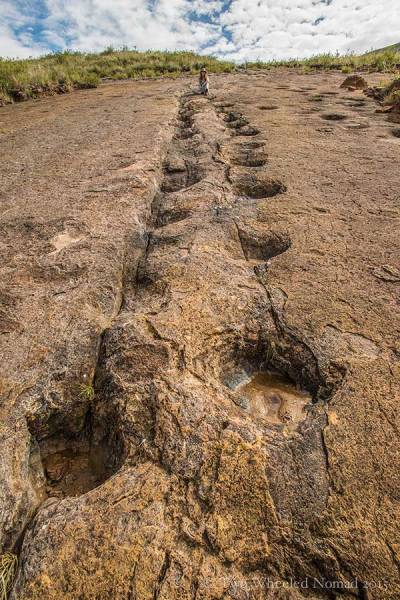
Over 16,000 miles now registering on the ‘Adventure before dementia’ mile-o-meter, we rode out of Cochambamba – but not before someone waved at us wildly from across the street. The young guy was one of the flawlessly English speaking Bolivians we’d met from the Dakar Rally in La Chita. Fancy bumping into him on a random Monday morning, 500 miles from our initial chance meet.
Further acts of randomness ensued when riding leisurely over a smooth ribbon of asphalt; Jason somehow managed to hit an unassuming rock. There was a gasp down the helmet’s intercom, like a wave pulling back over the pebbles but the impact was disturbingly gentle. A dull thud – like a soft unzipping, against the wheel rim. Still, it tore at Jason’s heart. Another dent in the wallet. The rim might as well have been made of chocolate.

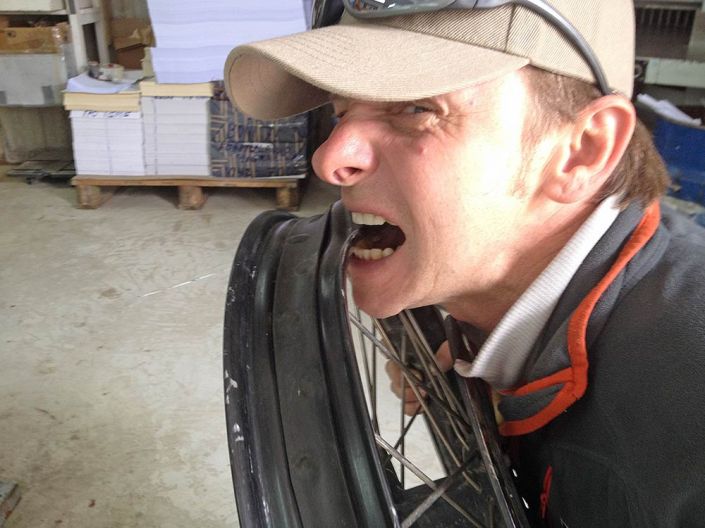
Under dirty cotton-wool skies en route to La Paz, we drifted precariously at over 4,000-metres through a cloudbank in three degrees and eye-squinting visibility. The mist clung to us, damp and chilly. Two metres in front and the fog swallowed Jason up; I moved through it like a blind man groping his way down an unfamiliar corridor. I felt icy fingers reaching through my clothing and goosefleshing my skin. A thin, cold rain swept beneath slate-grey clouds, growing darker and began to slant across the sky, fast approaching us. As the drizzle became heavier, the drops fell with an untamed intensity that made me huddle inside myself, clinging onto every vestige of warmth. A challenge for the spirits not to dampen under Mother Nature’s unyielding, wet spell.

It was the way our dice rolled all morning; no double sixes eventuated for us. Be that as it may, it paled by comparison when glimpsing an ill-fated, mangled dog nearby a man’s corpse, head bloodied and arms contorted strewn on the roadside. A shrill voice keened in my head. I brushed my hair from my eyes, along with a tangle of unpleasant and discordant thoughts. I think I started to pray. It wasn’t a conscious prayer, more a desperate and silent and unending plea aimed at grey sky, which offered no comfort. I let my prayer play out to an unquenchable thankful feeling, buoyed up by the action of breathing.
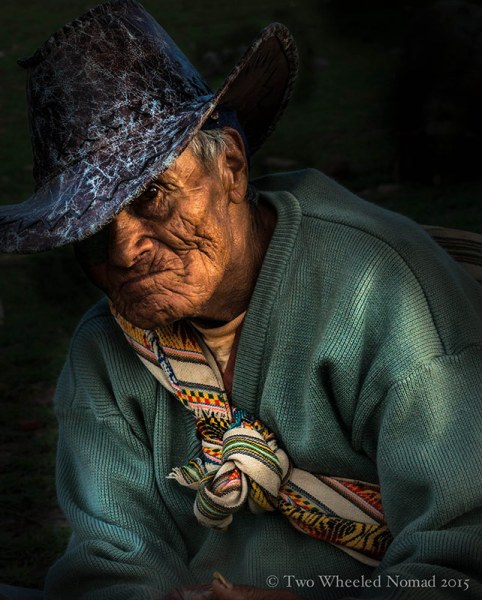
The intense hiss of rain, grumble of thunder and bone-chilling morning finally gave way to china blue skies and a skin-warming 20 degrees Celsius. A stranger by the name of Oscar had got in touch on Facebook three days previous; informed us he’d just picked up the Two Wheeled Nomad thread. Naturally he rationalised, would hear no refusals to his offer of invitation to come and stay. A week or a month, our choice. Having outlined a cheeky shortcut for us to avoid La Paz’s downtown medley of mayhem beforehand, we veered off the highway and pulled onto the top of a plateau overlooking a quiet valley of houses. Ten miles outside Oscar’s town, Seguencoma. The outlying fringe of La Paz – Bolivia’s second capital for the seat of government – is not what either of us expected.
My ignorance was repaired when the lay of the land revealed enticing green mountainous landscape, interlaced with a rainbow of coloured houses, neatly arranged upon steep, rocky hills. It was quaint, quiet and seemed safe from our vantage point. Not remotely akin to the negative picture painted in the guidebook, so often the way. Granted, we weren’t exactly downtown in the thick of the city but still.

We descended as though on spidersilk into a pretty neighbourhood of middling prosperity. I was so juiced, I had to stop the bike half way down to take in what my eyes were showing me. The landscape radiated an inviting appeal, optimised in a golden afternoon sunshine. I was pleasantly surprised and cruised the rest of the way at milkwagon speed as the genial town opened up slowly on either side of me.
Within five minutes of pulling into Seguencoma – another calm and gentle residential area – Oscar, his sister and girlfriend greeted us with an enchantingly polite reception. Their smiles unwithholding. He seemed a man of substance, someone seasoned a little by life.
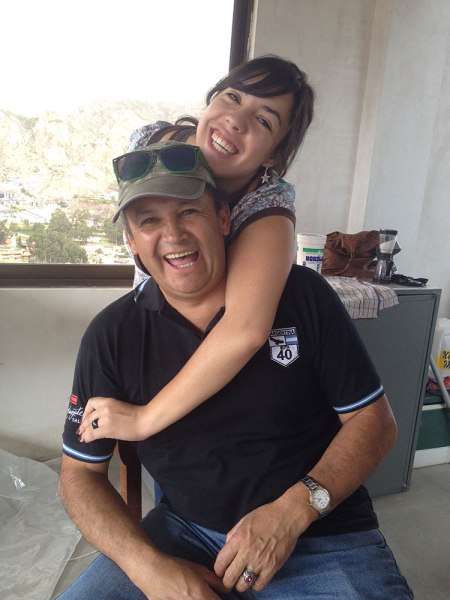
High up in the hills, a rather rocky and rutty one in particular, Oscar opened up his home. He placed a rum and coke into our hands, chilled by boob-shaped ice cubes. Having known of his existence for a mere few days, Oscar bit off his chortle and with a deadpan expression explained two obligatory house rules to respect. One: Treat his place like our home. Number two: Under no circumstance, must we thank him. For anything. We’d owe him many beers if we did. The flash of a serious frown clued me into his expression. “That is how it is”, he summarised, “You are bikers. End of.” He burst into hysterical laughter as if caught off guard from the brilliance of his own sense of humour. I warmed instantly to his unpretentious manner and beamed in his company.
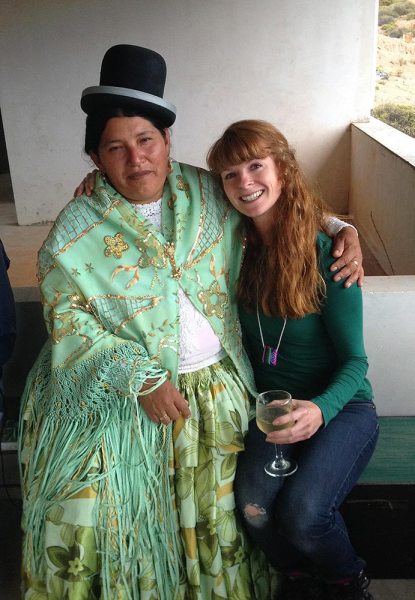
Oscar was totally at home in his own skin and I felt at home around him like I did with few people else. He had a refreshing and familiar way about him; able to express intense compassion for people and truth with unusual clarity. With a voice continually laced with bubbly humour, he also had an abyss of adoration for his 20 year-old daughter, Adri, alongside an unwavering appetite for motorcycling. Prioritising the repair of Jason’s chocolate wheel rim, Oscar took it to a Dakar racer’s mechanic without delay. Job done!

Unexpectedly, we were on the receiving end of barbequed, freshly-caught trout around the table with his daughter and sister, a steak meal with his girlfriend, and a day and almost night-long party with 15 or so of his closest friends. There we woofed homemade American-style burgers I’d prepared with all the trimmings, washed down with Chuffla – a thirst-quenching mix of Bolivia’s white grape Singani, soda and lemon. I danced until my thighs burned on the open-air top floor of Oscar’s apartment, mayhaps boasting the best view of La Paz. Competing admirably with the breathtaking views taken in on the teleférico – La Paz’s cable car – courtesy of Gaby, Oscar’s sister.
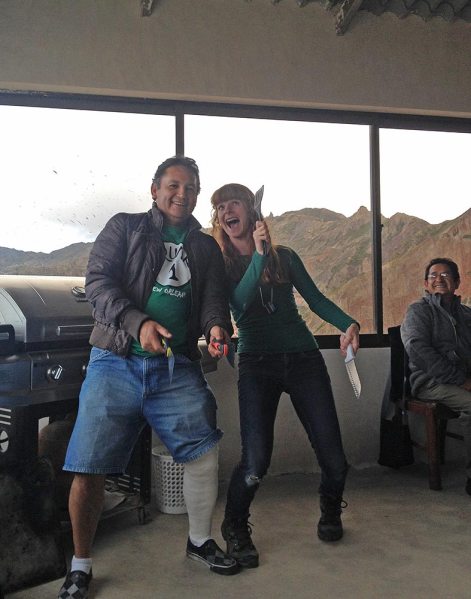
All of the above coupled with our bikes jet-washed, laundry sparklingly cleaned and bodies fed and watered, we were in dumbfounded disbelief of how exquisite our experience had been in La Paz. There was nothing not to like about Oscar, our welcoming host; the epitome of sociability.
10-12 Jan 2015 – The Dakar two-wheeled warriors! (2 of 2)

Background
Courtesy of the official Dakar website
The Dakar Rally Raid: The adventure began back in 1977, when Thierry Sabine got lost on his motorbike in the Libyan desert during the Abidjan-Nice Rally. Saved from the sands in extremis, he returned to France still in thrall to this landscape and promising himself he would share his fascination with as many people as possible. He proceeded to come up with a route starting in Europe, continuing to Algiers and crossing Agadez before eventually finishing at Dakar. The founder coined a motto for his inspiration: “A challenge for those who go. A dream for those who stay behind.” Courtesy of his great conviction and that modicum of madness peculiar to all great ideas, the plan quickly became a reality. Since then, the Paris-Dakar, a unique event sparked by the spirit of adventure, open to all riders and carrying a message of friendship between all men (and women), has never failed to challenge, surprise and excite. Over the course of almost thirty years, it has generated innumerable sporting and human stories.
The only way to complete the Dakar is through a combination of endurance and determination. The competitors will have an additional problem to resolve on the 9,000 kilometres to be covered in Argentina, Chile and Bolivia: adopting and maintaining the right momentum, while the route continuously endeavours to break it. Depending on the day, both the setting and the pace will change, moving from rocky routes to desert dunes and from endurance stages to extreme sprints. Given the competitors’ inability to recognize clearly identified sections, in particular they must capitalise upon their ability to adapt and to control their stamina. The marathon stages will definitely remind them of this basic rule of off-road races.

The Dakar tests competitors and their vehicles in extreme endurance. The marathon stages, where drivers cannot use their assistance teams, are a particular test of their ability to independently manage their mechanics. This year, cars and trucks, which have not taken part in a marathon stage since 2005, will have to tackle this additional difficulty. Split over two days, a marathon stage involves some of the competitors spending the night in an isolated bivouac. The vehicles are taken into a closed area, where only help between competitors is authorised. Despite the technical challenge that this constraint represents, the drivers also enjoy a different, highly convivial atmosphere. In Uyuni, it will be the car teams which will spend a night apart, followed by the motorcyclists and quad bikers the next day. The truck category will have its own dedicated bivouac in the middle of the Atacama Desert.
For several years now, the organisers have used their in-depth knowledge of the South American terrain to refine the routes and offer specific features for each category. For the 2015 edition, the motorcyclists and quad bikers will face an additional difficulty, with a particularly dense second week: four marathon days in total. 35% of the kilometres they cover without the cars and trucks will be in the form of special stages.
Our days at the Dakar, Bolivia
The seventh stage of the Dakar Rally at La Chita saw us watch an afternoon of cars bomb through the sand, braking momentarily only to register at the checkpoint. The sun, a white hot penny in the morning turned to lightning-charged skies by the afternoon. Lashing rain down on the racers and spectators dampened not a single person’s spirit. Witnessing history being made, right in the thick of it left me tingling from the inside out.

Newly but well-acquainted with the Bolivian blokes, the show for them had come to an end. Alas, they packed up their seven-tonne lorry to return home. Despite the inclement weather of iron-grey clouds and a sand storm in full swing, there was no way we’d be following suit. The biking warriors were due to race through La Chita the following day. But with the passing of time, and the departure of its main characters, the resultant mixture felt denuded and flavourless, like meat with the goodness boiled out of it. Overly inquisitive wide-eyed faces on legs started swarming towards the bikes. Without the protection of our makeshift compound in which we’d been ensconced, it was a tad intimidating to witness inebriated men succumbing to a strong urge of clambering all over our bikes like a climbing frame in a child’s playground.

As with all good books, every page is un-put-down-able. Just as one chapter finished for us, the next started. A new dawn, a new day. Darting my eyes wildly around the site, I glimpsed a rather impressive expedition truck. A Unimog. I rapidly developed an abiding interest in its owner. A man was leisurely sat on his deck chair, shaded by an umbrella on the roof atop his all-wheel drive, all-terrain truck. A robust thing, which had a ground clearance of about a metre, the tyres looked like they’d been extracted from a tractor and it had a distinctly lock-down air of security to it. We’re talking: extreme torsion resistance, a welded frame, fording ability, coil-sprung axle suspension and stable portal axis with a hydraulic system. Go figure, the Germans know good engineering. It came as no surprise when a passing American girl ventured over, the cogs turning as she was trying to process the image of this vehicle before her. After a few moments, she smiled and remarked, “So like, I guess this is what? An intense trailer?!” I guess so.

Meet Franz and Ingrid, a retired couple in their fifty-something prime of their lives. Travelling to their hearts’ content. Franz spoke with a fierce and urgent vividity, his blue eyes shining as he brought the subject of travelling through foreign lands into sharp focus. He regaled us with his truck-bound journeys; as a skilled storyteller, his vocation offered a deep resource for some forthcoming tales. He remained humble about the Unimog yet nostalgic when he clocked our bikes and the ticket to freedom that two wheels bestow. The couple was as gracious as they were generous towards us. The pleasure was all ours. Retreating the tent and our somewhat exposed motorcycles under the safety of the dominant Unimog, we’d found our new home for the next stage of the Dakar.

Armed with sunglasses, sunscreen, cameras and waterproofs, we headed off to spend a second day under lightning-charged, bruised skies. The first batch of 30 dirt bikers descended. Including female rider Laia Sanz, her ponytail bouncing up on every corner as her wheels left a spectacular sand cloud in her wake. Respect! I blinked in shock from the insanely close proximity we were from the racers as much as the dust. Crowds either side were no further than around two metres from the action, edging closer as each rider zoomed into view. Only in Bolivia…!

Army recruits were too interested in the race to mind about something as trivial as folks running across the track every three minutes. Taking selfies and filming, cheering on the crowds and purchasing sunglasses seemed to be the order of the day for those in khaki uniform. For every adult man, I clocked nine boys of pubescent age. A total lack of organization and safety, at least no one was hurt for the fortunate part. What a sight! The official Dakar programme informed readers how Bolivia will – like the previous year – once again “amply satisfy” all requirements of the rally’s enterprising organisation. Definitely the land of stark contrast, colour and crazy.
Rooting specifically for two riders, a father and son duo Simon and Llewelyn Pavey – we waited for their eminent arrival – numbered 76 and 75 respectively. Through intense sunrays, which gave way to a dramatic purple sky, thunder and lightning played their part while we continued to watch and wait. Hours passed. Each time I examined a rider’s identifying number, a bit of the excitement dispersed, like a pool of shimmering water that evaporates beneath the midday sun.

I didn’t want to but couldn’t help wonder if our Aussie shining stars, usually residing in Wales were still in the race. Of course they were, despite a couple of crashes and nasty encounters with dehydration, altitude sickness in -9 degrees Celsius conditions and dizziness requiring oxygen and a drip en route, the boys were faring incredibly well. Their official website and social media were keeping us well informed by the hour. More time passed and a relentless rain began to fall. Temperatures plummeted and the thought of a hot drink to revive the cockles settled on my mind like a nylon cloth and wouldn’t let it breathe.

Killing more clock towards the back end of a cold, drizzly afternoon, we finally retreated to the coziness of the Unimog. There was a lull of riding anyway where only the odd quad and biker caught our attention sporadically. Then Simon and Llewelyn came through. Triumphantly passing the seventh stage. It was a moment of pure elation for us; it must have been euphoric for them. And relief mingled with chronic exhaustion probably. I waved my arms crazily, like a trapped moth in the hope of attracting their attention. I was too far away and felt my body crumpling under the shame of not being closer, like a sheet of newspaper burning in the fireplace. All night, the thought of catching them on the morrow niggled away at me. I would not let these men down through their heroic marathon.
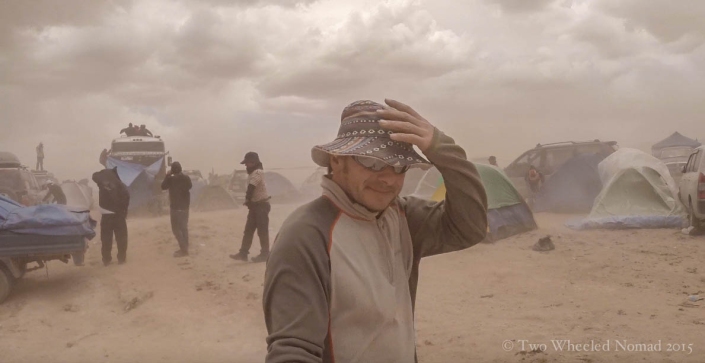
A night of torrential rain left the tent bobbing in a lake by morning. Not an ideal start but not a deal-breaker either. We packed the tent down in record time, said our Auf Wiedersehens to our Deutsch freunds and headed straight to the Salar, the start of the next stage. The road under construction was slow going but made easier by filtering routes back onto the intermittent hardcore. It enabled us to claw back a bit of time, a small boon at least. Pearl’s never been one to relish the wet, this occasion was no exception. Pray old girl, just get me to the Salar. Putting my selfish needs before her own, I ignored the sluggish movements of my trusty wheels and sighed in resignation when Pearl put her foot down. Going nowhere, not least the eighth stage of the Dakar.

Five miles from Colchani, I studied my options as I surveyed the scene. I could abandon Pearl and ride ‘two up’ on Jason’s bike. Or perhaps push my motorcycle through the mud bath of slippy dirt. Out came the towrope. It was wet, the ground was squidgy at best and the puddles the size of paddling pools at worst. It was actually quite good fun once I got into it and picked up the technique without any snotting and screaming. “You did well today”, Jason surmised as I detected just a hair of relief in his voice. “Thanks!” I responded, without keeping the relish out of my voice. Riding side-by-side or in our case ‘subframe-rope-to-foot peg’, we gained independence and proximity. Motorcycling will leave you dizzy with a sense of liberation. All you need is an open mind and a cast-iron gut.
Jason rumbled Pearl back into action at a gasoline station while I chuckled that we were splattered helmet-to-boot-tip in mud. My hair had taken on the texture of straw and I was sporting black rings around my neck, which complemented the thick streaks of black embedded under each fingernail. A by-product of having too much fun in the desert over four days with no facilities. Without delay, we bobbled over the corrugations and squelched through the mud onto a wet Salar de Uyuni.

We were too late. Cars were inching away from the Salar while we pushed towards it, refusing to believe we’d missed the start. It had gone 9.30am, of course we’d missed it. Officials were turning traffic away from the Salar, assuming everyone had had their Dakar fill. What left me so royally out of favour with myself is that had we pressed on a further five kilometers onto the Salar to the worldwide collection of flags were located and well, not broken down, we would’ve caught the the riders leaving the salt flats. Our good intentions had turned into a complete debacle! The odds were stacked against us, we’d missed the boat and the bikers. Life would invariably continue, the rain would carry on falling and I suppose I was resigned as the Bolivian beggars who sat outside most city street corners, my hands outstretched.

Bolivia, I’ll say again, is the land of contrast. Her sun is devilishly hot but when she feels capricious, she’ll banish all warmth to be replaced by golf ball-sized hailstorms come the afternoon. She’ll give you strong WiFi but weak sanitation. You might think the local drivers who appear kamikaze – compared to those in Argentina for example – are out to kill you; they’re not, they’ve just never had to take a driving test on a par to British standards. Every street corner you’ll see 19th century bowler-hatted women clad in a silky shawl, llama-wool cardigan and traditional pleated skirt walking alongside their children donning ‘Ben 10’ tracksuits and Nike trainers. In front of them lies a mirage of commerce amid barminess – changing every paradigm and preconceived idea of the place you ever had. There is even an ineffable grace in the midst of squalor.

The start of second stint in Bolivia was far from brutal compared to the initial experience. My efforts to tune into the country during the first time round felt phoney and misguided. By the country’s own volition, this time was brilliant fun; connecting with the locals left me giddy with a sense of warmth and magnanimity only fellow motorcyclists seem to share. The friendship, fond regard and affection that only riders and their motorcycles can ever know, we humbly reaped the rewards of camaraderie that is the fellowship of the road. Like a kaleidoscope, Bolivia had shaken me and settled my pieces into a different arrangement.
Thanks to SP Fifty One for capturing fly-by-the-seat-of-your-pants action shots of Simon and Llewelyn Pavey.
1-9 Jan 2015 – Pit of Potosi, sugar in Sucre & a lively band of Bolivians (1 of 2 Dakar)

(Part 1 of 2 Dakar-related posts)
“Break the boundaries of a limited mind and body. Experience bliss throughout yourself and around yourself. Find yourself in the Ultimate.” I’m beginning to identify with Swami Purna’s reflection.



New Year in Salta cost us several arms and legs. Jason’s fuel pump had given up the ghost, not favourable on our budget but one of those hidden costs we’d simply have to take on the chin and write off. Ruta 51 from Salta kick-started the New Year at the crack of sparrows with a 100-mile ride along Rosario river, fun sections of dirt and asphalt to a rest-stop in San Antonio de los Cobres. We were headed to La Quiaca via an old section of the ruta 40 where the rugged ripio eventually meets the smooth run of ruta 9. An overnight stay in the dusty desert town and two melt-in-your-mouth meals consumed at San Antonio’s Quinoa Real cafe later, gave me the energy to jump straight back on Pearl and tackle the 58 miles of thankless tract, which grew mostly rocks, hand blisters and busted hopes.
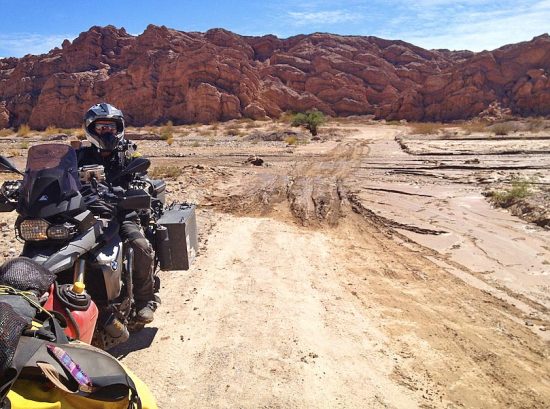
Handling Pearl – leaden like a pack mule at altitude over coarse sandy corrugations – I was asking a lot of her. One of her fork seals was leaking oil, her chain on which I was about to further yank had seen better days and goodness knows how her worn shocks would fare over the jolting bumps. Why did my mood become so capricious on slightly technical terrain, which seemed so inextricably linked to my off-road performance? I’d become rusty was all, my skills and comfort zone out of kilter. Over-caution embedded into the physical rigidity carved into my body gave rise to a basic distrust of sand. I felt a web of small cracks scoring into my mood like the crazing on old china.
Marshalling my energy, I eventually rumbled Pearl into action for the remaining 30-mile section. My muscle memory kicked in half way through the episode making my foray back into off-roading tedious and punishing rather than terrifically tiring. Time was well overdue to relax the antennae I’d raised in fear of hurting myself on sand at speed; I allowed my body to be pumped in the capable hands of Pearl. It took a while but I liked Pearl’s self-possession and her dangerously unknowable edge. We were in agreement, at last, “I am woman, hear me roar, watch me ride.”

Our tyres eventually hit a surface recognizable as roadway, the humming of Pearl’s tyres back on the asphalt lulled me into relaxation. With over 15,000 miles clocked on South American soil, we eased our way back into Bolivia. The land where they give their buses names like Alison and Jesus, a land so high the air escapes you. It’s home to the multicoloured back-wrap, the bowler hat framing long black braids on women as well as riots and street parades erupting without warning. It’s a place of contrast, curiosity and for us, a constant headwind.

After four inefficient hours, we inched our way over Argentina’s La Quiaca border into the bustling southern city of Villazon. If our first encounter of Bolivian traffic was anything to go by, I didn’t hesitate to put Pearl back into survival mode and her most aggressive gear. You won’t faze me this time, road-razzing Bolivian crazies. I ignored the best course through the apex and stuck to the outside white line like glue, cornering every curve like I was on rails. Slower and cautious was preferable to oblivious and unconscious. Jase put me in front to cut down on the ‘dawdling’ to which he’d sardonically refer, hang on, dawdling is one of my favourite pastimes.
On the edge of the country’s altiplano, we found ourselves at over 4,000 metres – occasionally dropping to the oxygen-rich 2,500 metres. The air was thinner, the drivers less than considerate and the llamas unperturbed by our motorcycles’ roar. I was growing re-accustomed to the new daily grind, the rise and fall of this unpredictable country. I wondered if this time round, we’d find its hidden depths.
Deep in the bowels of Potosi: The silver city that once was. Founded in 1545, soon after the Spanish stumbled across the Cerro Rico – Rich Hill – looming over the city. This mountain harvested enough silver to bankroll the mines. As our bikes rattled down cobblestones and through the crowded streets of a late afternoon, local drivers must have pipped at me more times than I’d had hot dinners. Horns hooted constantly at me in that city-based passionless way – nothing personal, just a reflex action. It was simply the way of it here; if you don’t push your way into traffic with purpose, no one will let you in.
Our second sojourn in the city left me seeing the same – Potosi was riddled with filth, the destitute weathered by hardship, scraped a living amidst the traffic and the slums clustered around firearm-guarded banks. An unmistakable undertone of its sad stories, past and present. Seeing the odd toddler wrapped up in llama wool to keep in their little body’s worth of warmth, jangling key rings gone 10pm at night plucked at something very deep in me.


Sucre, just a scant 100 miles northeast of Potosi saw us savour some sugar at Café Florin; a three-course meal for an economico 35 Bolivianos would be less than £3.50. It was mouthwatering to boot. A first-floor apartment catering to all the needs of a modern motorcycle traveler also had us blinking in shock when we rocked up a few blocks down the road at Hostel Wasi Masi. Arrr, the moment when your faith is restored in budget travel through South America’s most impoverished country. It was altogether sublime. The sky turned from midnight blue to charcoal, and the light from the streetlamps glowed gold in the fine evening mist.

Returning to Potosi, we rode under a leaden sky that was bleak and raw. A torrent of monsoon rain forced us to don the ‘super-suits’: an all-in-one, super-sized, non-breathable black number with ample room leftover for another me. I could quite possibly have been mistaken for someone the size of Belgium. Fashion kudos aside for one moment, surely it’d be in the running to win drysuit-of-the-year for keeping every drop of water, wind and cold at bay. It saved our skins and allowed me to ride with that snug-as-a-bug feeling outside – come rain and hail without shine – somehow reveling in it all.
On arrival, a fierce gale tore through the streets, along the alleyways and across the open spaces of the city; ripping newspapers from unwary hands, seeking out ill-fitting doors and loose window frames, whipping litter to head height and bearing it across the plaza. Outside was the hooting traffic, the cacophony of the street but once through the doors a hush fell, as if the hostel created its own silence. I peered out my window and the place looked eerie at night, bathed in a sodium light.

Cruising into Uyuni’s intense light the following afternoon, the Dakar rally-inspired carnival and markets bustled in full swing. An excited buzz filled the air as locals, bikers and travellers jostled for space between the stalls packed tightly with street food, mocochinchis – sugar-sweetened, dehydrated peach drinks and an A-Z assortment of Dakar-related memorabilia and merchandise. We pushed the side-stands down to the nearest street vendor, ravenous. Promptly serving up the Menu del Dia – an inexpensive, set meal for the locals – we dived into a steaming bowl of roasted llama on a bed of hot, fluffy quinoa and fortified ourselves for the hours ahead.
Resided to the fact that Uyuni’s accommodation would be four times the standard rates – who could blame the locals for making their moolah over the Dakar rally – we headed straight to the Salar to find out where the daredevils would be blasting through to complete the seventh stage of the race.
The Dakar rally raid is a fortnight long, off-road endurance race. Riders in highly modified cars, trucks, on quads and dirt bikes need Trojan-level stamina and a dogged perseverance to rocket like a bullet across every terrain known to man covering up to 900 kilometres (560 miles) per day. The race kicked off in Buenos Aires on 4 January, headed northwest on a circuitous route into Chile, as far up to Bolivia’s Salar de Uyuni, south through Calama in Chile and diagonally cut back into Argentina to the starting point and finishing line, Buenos Aires.

Punishingly grueling doesn’t remotely cover the intensity of racing in the Dakar. Temperatures of around 50 degrees Celsius were being reported by riders in the desert while sustaining hundreds of miles of dunes, mud, pampas grass, rocks, sand and fesh-fesh (moon dust), dirt, gravel and riverbeds. Serious altitudes and bone-chilling cold on top – the riders will have needed to summon Herculean mental and physical strength to sustain themselves over the 13-day race. My feelings of inadequacy on the sand compared to what the Dakar guys and gals would endure was spectacularly comical. Finishing the race is the ultimate achievement in itself, let alone going like a bat out of hell to win first, second or third place. Rooting for father and son duo Simon and Llewelyn Pavey comprised a big motivation in experiencing part of the Dakar.

With the road en route to Salar de Uyuni still under construction, we were forced to ride in the dirt to reach La Chita. My latest assault on the sand left me feeling very Monday morning-ish. Sensing Jason’s waves of frustration snaking my burdened path, I was beginning to miss both the point and the boat. All I wanted was two-wheeled peace instead of the spirited minefield of my emotions against Jason’s expectations. I didn’t want to give up my confidence or my headspace, to sand, of which would inevitably overwrite it with its own needs, desires and wants. But relationships are fraught with grey areas. It’s not always possible to do what, in other circumstances, one would feel is the right thing.
Furrows of concern formed between my eyebrows, I was starting to feel like a country song, “There’s something wrong about not feeling right.” I sensed a tectonic shift between the correct conduct on the sand and my current riding behaviours. Now I was caught up in a triangular turmoil and, like the delayed wash from a passing liner, the swell of tension between Jason, the sand and me was rocking my own comfortable boat.
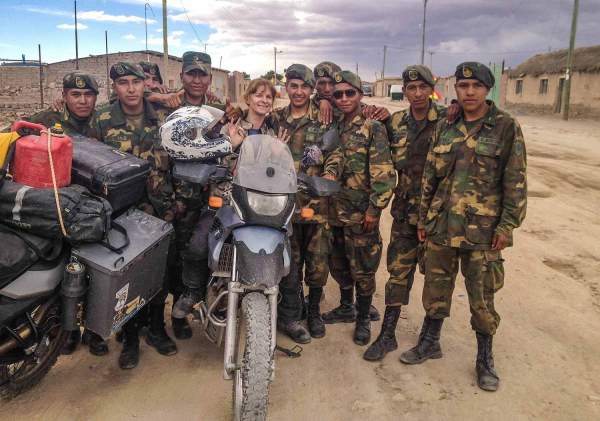
Positively pushing me on, I straggled behind Jason until we reached Colchani. In fact, I hadn’t realized at the time but I’d ridden the briefest section of the Dakar race! Go me. Seconds before each patch of sand, the words ‘Keep the gas on’ with a gulp surged into my mind and left my insides turning to jelly. “Oh come on Lisa, it wouldn’t be so bad if I knew you couldn’t do it. But I know you’ve proved time and time again – you CAN DO IT.” I felt sympathetic towards Jason’s ongoing patience but his words still elicited the same response from me. Slowly, slowly, catch a monkey!
The ruddy sand threw me into a constant state of flux; it was the agony of acknowledging what I should be doing on the sand, along with the pain that neither logic nor understanding could dispel. I was disintegrating in a welter of waning confidence and collapsing morale. I was starting to disconnect with Jason and put up a protective shield. The trouble was, the more I neglected to adopt a ‘Get on with and go for it’ mantra, I watched myself becoming more whiny and resentful; I was becoming hateful to myself. This vicious circle was creating a lack of affectionate ease and companionship between us – taken for granted usually – that I so badly craved.
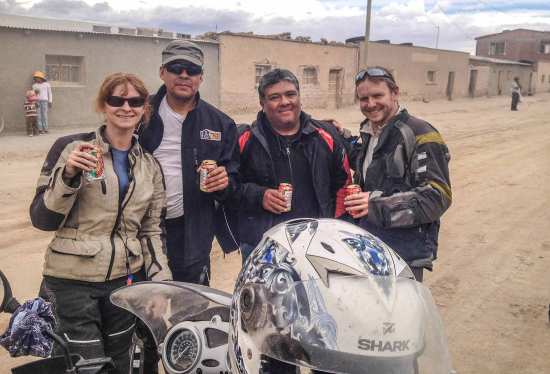
En route to La Chita, we bumped into a gregarious band of Bolivian bikers. Ricardo introduced us, exuded a gentle bonhomie and told me he’d be leaving his motorcycle behind, apparently didn’t like handling it in sand. I hear you fella, I hear ya. Beer can thrust in my hand, these guys were having a ball on their lad’s weekend jaunt. I took a long pull of the chilled welcoming nectar and smacked my lips. That should loosen me up.

Rapidly becoming jaded with ruminating on my own incompetence tinged with an erratic riding style, I fixed my eyes on the middle distance and opened Pearl up. “Vamos, lets go Lisa!” she roared. I flicked the switch inside my head and felt like a pit pony loosed into the sunshine. Anything was possible, despite being a little tense and ready for battle. But after the 26 sandy miles to La Chita, nothing eventuated. I was still in one piece. Now there was a large and beautiful logic. I’d done it, albeit with a lacking equanimity. May be what happened was a portent, a warning to me that I MUST get over myself, out of my own stereotype and the cringe-worthy, reticent rider I didn’t want to be.

The Bolivian guys took us into the fold, set up camp at La Chita and used a lorry truck and several Bolivian flag posts to assemble a square tape-bound section of our own turf. A generator, sub-woofers, a big barbeque grill and crates upon crates of beer were unloaded while we looked around, our faces in a rictus grin. We were with these locals to experience the Dakar, only by chance. Waves of people started appearing, a sea of tents popped up around us and the official organizers among troops of soldiers made their nebulous presence. It took me a while to realise they were there at all.
An onslaught of curiosity ensued, our wheels magnetized in the masses – subjected to an afternoon of photo-snapping, trigger-happy paparazzi. We’d been welcomed in by hordes of Bolivians and it felt wonderful. China-blue sky darkened to navy and the sun rested, a crimson orb on the horizon, turning the clouds through gold and orange to deep rose and purple.

Victor, one of the guys in the group approached me with a glint in his eye and a bottle of unknown substance in hand. I took a sip of the potent concoction, which burned all the way to my toes. The next thing I know, he grabbed my hand and a fast and spirited salsa began. I was in my element, dancing with a newly acquainted partner – in this case a Bolivian chap whose feet stirred a rustle of delight in our audience as he swept me along to the rhythm of the music, hurling me mercilessly to the end of the song. Victor, the music, the place – it all infected me, lifting me out of myself, any inhibitions and into the spirit of the dance. Victor was thrilled I’d committed, kissed my cheek and forewarned me I’d be in for another with him shortly. I coquettishly raised my eyebrows and Victor gave me a conspiratorial wink. Smiling, I tried to discreetly burp as the beer and barbeque tangoed noisily and decided that another swig might fix it. What is it about salsa that gets you out of your head and into your body, making seeing everything more clearly.

After the last dance somewhere in the wee hours, I bowed my head with half-closed eyes; I probably resembled a sleeping reptile. A rollercoaster of sand riding, the altitude and salsa’ing all night in cumbersome motorcycle boots brought on an unbeatable urge to inspect the insides of my eyelids. Jason too must have been exhausted as sleep took him before his head hit the pillow. I fell into a deep, undisturbed sleep broken only by an audible realisation that I’ve never known anyone who can fart and snore at the same time. We slept beautifully. Sleep was so simple, especially when one was gazebo’ed!
In a pearly morning light, I emerged slowly from the fug of sleep and quickly remembered the previous evening’s pleasure at the hands and feet of Victor. That guy had the lightness of a panther and the speed of a leopard. Jason rose with the same delight that I’d found someone to play with all evening, in this baffling and beguiling country.
Part two on the Dakar coming soon…think Dakar warriors en motos!

Cheering on the cars under lightning-charged skies at the Dakar
8-31 Dec 2014 – Act II: North proper

A friend recently enlightened me to the fact that the science behind everyday life does indeed lead to human progress. Christmas is a pertinent time of year to combine these merits with the festive holidays. While currently in South America, personalising greetings cards online – comforted in the knowledge they’ll be delivered on one’s preferred date to the front door mat of anyone worldwide – has been a breakthrough. The era of instant gratification has revolutionised the emotional management of our ties back home whilst overseas, thus reconciling the traveller’s conscience a little. FaceTiming family and Skyping friends to any corner of the globe is priceless, compared to the face of technology back in the day. Especially when on different continents if not in opposite hemispheres to our loved ones. Cherishing my young Aussie nephews jabbering away in real time on the webcam is as good as it’s going to get this year but I’ll take that over the more traditional means of postcards and pipped payphone calls any day. Keeping abreast of the minutiae of everyones’ lives on FaceBook can be a blessing and a curse – I’ve somehow accumulated over 3,000 friends and sure hope they don’t descend on us for a cuppa at the same time. I wouldn’t have enough teabags.
 Surviving our nomadic lifestyle owning nothing more than the contents of our panniers and a roll bag somehow brings it all home; the unconventional science of being in the outside world more than indoors, zooming through space astride two wheels on unexplored territory and living out an adventure beside each other is well, as close to liberation as it gets. Certainly for us. We want for nothing on the road but are forever absorbing what the world has on offer.
Surviving our nomadic lifestyle owning nothing more than the contents of our panniers and a roll bag somehow brings it all home; the unconventional science of being in the outside world more than indoors, zooming through space astride two wheels on unexplored territory and living out an adventure beside each other is well, as close to liberation as it gets. Certainly for us. We want for nothing on the road but are forever absorbing what the world has on offer.
But more than just motorcycling, which is empowering as much as it is our transport, I watch Jason indulge in his passion, honing his craft through an exact science. I see him shooting his camera, considered and focused only by the task. Heuristically learning more creative knowledge by every exposure generated. Every time I hear the click of the shutter followed by that faint rustle, it reminds me when I used to catch grasshoppers as a kid on holiday, trapping them between my cupped hands to take a closer look. I thought it was the same with photographs, only now Jason seizes time and fixes it in digital, capturing it halfway through its jump toward the next moment. It immortalizes special moments and preserves our memories, this one life. He was in his element – don’t ask me which one of the 92 found on Earth but he was fervently in his.
Boom! We’d fallen off lenticular cloud 9 with a bus-banging jolt. Goodbye Antarctica, hello Argentinean bus ride from hell. Alas, it was time to head north proper. Something we’ve been threatening to do for the last nine months. What can I say? Argentina is an awfully distracting place.

Our experience of Andesmar buses in Argentina to date had been sound enough. Four-wheeling us from collection point A and depositing us a day or two later at our desired destination – Iguazu Falls and Ushuaia’s port. Freedom and autonomy out of the bus-window but at least without hassle or hindrance. That is, until our latest bus-going epic occurred, which was as tedious and uncomfortable as one might imagine. It was so snug and stuffy, a hibernating squirrel might become ill at ease. I hunkered beside Jase, feeling sorry for every canned sardine out there. What started as manageably dull morphed into: tuneless music blaring around teenagers, whining children and crying babies. How could such little creatures make such unbridled, incessant noise? It pierced the ears like a lancet, almost painful.

Every half hour the bus’ air conditioning kicked in, just to ensure everyone was getting their fair share of snotting, coughing, wheezing and sneezing circulating – akin to a doctor’s surgery during peak flu-season. I clocked a guy next to Jason lying down horizontally in the aisle, erupting goodness knows what all over us from his spittle-soaked mouth. It wasn’t a mere frog-tickle but a whole-hearted-with-both-lungs devotion in emptying the contents of his throat. My jaw was working overtime in a mute fury and it demanded a colossal effort of will not to scream “HAND!” in Spanish at the insufferable chap. “Give us that small boon, I’m begging you”, I muttered under my breath as he spluttered.

One mother took to feeding her toddler milk until the poor mite could stomach no more. The little girl went wide-eyed, heaved every bottle of the bitty lactose substance back up, after which rolled as a sea of white – up and down the aisle for the duration of the journey. Befuddled to the roots of her hair, the mother proffered yet another bottle of milk to the child. The erratic and deeply unnerving behaviour of humans begs belief sometimes. Pure chaos seemed to reign; it was the bus ride that just kept on giving. Including a constant judder to my seat from the kicking legs of a bored-out-of-their-box child behind me. With every ear-plugged mile, I pulled any semblance of quiet towards me but pushed away a growing conviction that I needed to be heading out of Argentina, not settling more deeply into it. I quietly nodded at that rather discordant thought.

A grand total of six buses, six days and 147 hours of eternity later, we arrived back to our starting point. Mendoza was the temporary resting place for our bikes while we’d got down to four-wheeled bus-iness. Bodies started shifting suddenly from their seats until every person was fleeing to make a mass exodus, like ants from a stirred nest. My body had aged a couple of decades in the past 48 hours; I stifled a groan like a much older person as my shoulders returned to their proper angle with a crack felt in the bones. Within a couple of days, forces of inevitability had conspired when Jason went down with the flu (not man-flu), while I developed a raspy breath with the gravelly voice to match. Prone to countless dry coughing fits, it felt like I was swallowing broken glass pushing saliva past tonsils the size of tennis balls. Ah, the joys of an acute throat infection attached to a body spiralling into hot and cold sweats.
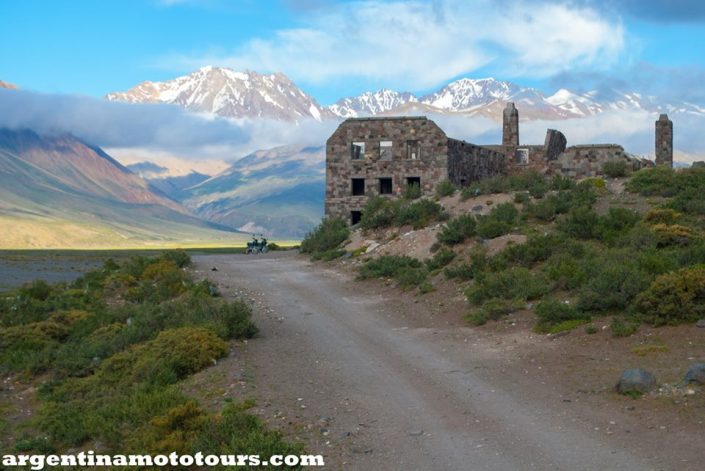
And where were we? At the point of no quick return; out on an off road trip miles up into the Mendozan mountains with our biking friends. As Juan-P’s good friend Jeff had flown in from the States specifically to ride, Jason was committed to finish filming a promotional video with them all for their moto-touring company, Argentina Moto Tours. I should’ve stayed put in Chacras de Coria and instantly regretted my lily-livered decision of not wanting to ‘miss out’. I had just enough of an incline beforehand to leave Pearl behind and ride in the truck. That’ll teach me to ignore the health warnings flashing like a lighthouse beacon from my body.
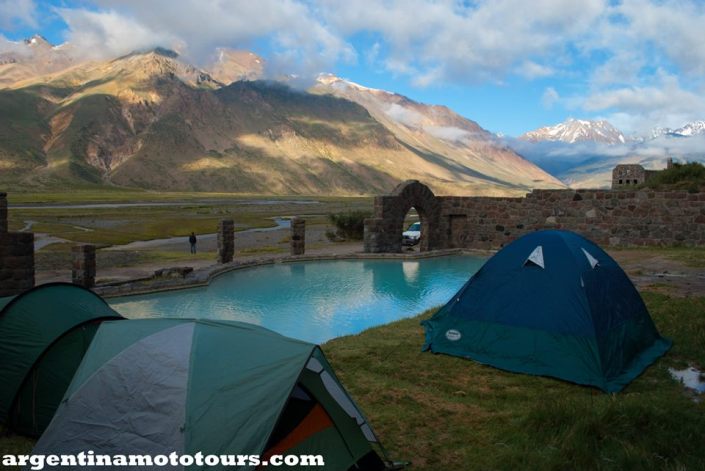
As if birthed by the sudden awareness of my illness, a dull pounding began crawling up the back of my head. I gingerly inched my way toward every opportunity to lie down and sleep, humbled by the powers of a weakened immune system and an acute virus. About as fun as a funeral, I disappeared into my shell like a turtle protecting its soft underbelly from anything potentially dangerous. I didn’t want to start spewing my pain and anguish on everyone around me. A significant throbbing continued, emerging like a humpback whale breaching the wild waves of my thick hair.

The views from every location chosen for the remaining 45 seconds of footage required were stunning. Yet I still wanted to curl up and vegetate. My head was thumping more than ever, like little trip hammers beating to the rhythm of my heart. Had you have thrown a bag of $100 bills at me, I wouldn’t have batted an aching eyelid. Armed with prescription-strengthened Paracetamol from over-the-counter and throat lozenges instead of antibiotics, I placed all the healing power I could summon into fighting off the wretched infection coursing through my veins. Thankful that I hadn’t been sick all year, I had to stay in full agreement with Yazz, a singer from the ’80s, “The only way is up, ooh baby…for me and you now”.

Feeling my sprightly old self again just in time for the festivities, I started to relax and enjoy the run-up to an unconventional Christmas. Our budget for gifts this year derived from an entirely different currency – the heart. We presented Juan-P and Toto with the polished short-film promo video, watched with baited breath and awaited their response. Result! Fraternity brothers couldn’t have pawed each other with more affection. There were glassy eyes, big man-hugs and so much gratitude mingling with immeasurable pride, I all but became a sobbing mess. Back in the net, Jason!
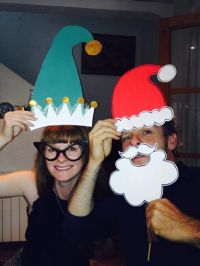
Argentineans start their big-scale, family-oriented merriment on Christmas Eve, enjoy a big celebration dinner with extended family while fireworks sparkle and fill the skies at the stroke of midnight. No Brussels sprouts, Baileys or bread sauce this year, we consumed a veritable feast in a buffet-style banquet. The delights on the table left us feeling decadent and satisfied. Washed down with a Juan-P’s family vineyard Malbec as opposed to mulled wine. And instead of getting toasty before an open fire from sledging in the snow, we cooled down in the swimming pool before slapping on sunscreen and sun hats. Surrounded by four generations of family, it was a rare and precious moment that catches you by surprise. As Christmases go, ours this year was strikingly alternative.
Taking a full day to adjust back into the swing of munching miles on the road, initially I felt torn in leaving good people who’ve become lifelong friends. There were ribcage-squeezing hugs with heartfelt promises to meet again, gifts of wine and tea bestowed on us and a plethora of pictures taken for good measure. After killing more clock with fond farewells, our wheels finally started to turn; my vision a little blurred and bottom-lip out. It was as though I could feel a sadness slowly tightening around my chest and heart like the crushing coils of a constrictor, squeezing liquid from my eyes until there no longer remained a reservoir.
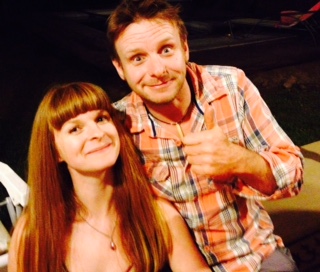
Under iron-grey skies, my face was a study in storm clouds and my mood was bruised; black, vermilion red and a deep shade of purple. Irritation radiated off my shoulders; I didn’t want to leave but couldn’t stay either, risk outstaying my welcome on top. My stomach was a ball of motion and turmoil so I simply rode in an emotionally-strung stupor. Stop blighting your own day, Lisa. The pair of us had to deviate back to the Two Wheeled Nomad plan; Argentina to Alaska! We began to trace our way millimetres then eventually centimetres up the map. The first 100 kilometres were always going to be painful. It was Boxing Day. All I could hear was the excited racket of cohabitation where every household that day was open to family and friends. Many childrens’ voices fought to be heard amongst one another’s houses. Christmas is definitely for children to maximize being a kid. I thought of home and hoped everyone was having a ball.

While some folks back in Blighty were battling with inclement winter weather and praying for a solid smattering of snow for the kids, we were bubbling to boiling point in white hot temperatures. Summer in northern Argentina soared up to a skin-blistering 39 degrees Celsius making it more than moist between the motorcycle gear and me. I was having my own personal summer inside the suit; like an unending gentle rain pouring down me. Had I removed my Gore-Tex and armour-reinforced ensemble, you’d have seen me sizzle like a sausage. Granted, I’d rather be on the warm side astride two wheels as opposed to riding through a torrent of rain for example but motorcycling in temperatures hot enough to melt lead made the sun an executioner and the roads a furnace. Suck it up princess, I kept reminding myself.
Jason’s bike loathed the sweltering heat as much as he did; a suspected failing fuel pump making it intermittently conk out on the spot. The sullen wet heat sapped more than his bike’s strength, we’d leap into the nearest shade every few hours to take refuge and fall asleep in a soggy heap. What a pair of pansies! Furiously hot rapidly became our new norm but at least we were cruising northward through pretty places in Argentina’s wine country such as Cafayate and Cache in hairdryer heat as opposed to pedaling through it. That would be extremist behaviour and helmets off to anyone that has or is doing just that.
26 Nov-7 Dec 2014 – Purest place on Earth: Antarctica!



“There’s no Antarctic ocean on the maps. The cold waves that beat against the Antarctic continent are from the southern portions of the Atlantic, Pacific and Indian oceans, and in their flow around the ice-rimmed land they mingle to form one vast gale-swept wilderness of water.” Russell Owen observed as he nailed the essence of where we were headed.
Sturdy, hardened to Mother Nature’s ferocity and outwardly up-to-the-job, first impressions of our Yugoslavian-built seafaring vessel told me we’d be in capable hands. After an excited embarkation on the ‘Sea Adventurer’, I surveyed the scene aboard 100 metres of promenade-lined and plush surroundings: A gourmet dining room, library, personalised cabin service and a spacious lounge complete with an impressive coffee and cookie station. Punctuated mind you by a succession of sick bags, tucked into the ship’s hand rails ubiquitously on every deck.

Oh joy, here comes the chunder-induced pain before any gain. No, don’t become disenchanted before dipping even a big toe into the seas off the Antarctic – go figure when three oceans converge while circumpolar currents surge. An early presentation aboard the ship restored any waning confidence in conveying that our vessel was adept at ‘bio-mimicking’ a whale. Smooth, streamlined and evolved, Olympians of the sea totally in touch with their bodies – I optimistically interpreted. Like an orca then, I resided to keep my eyes on the prize.
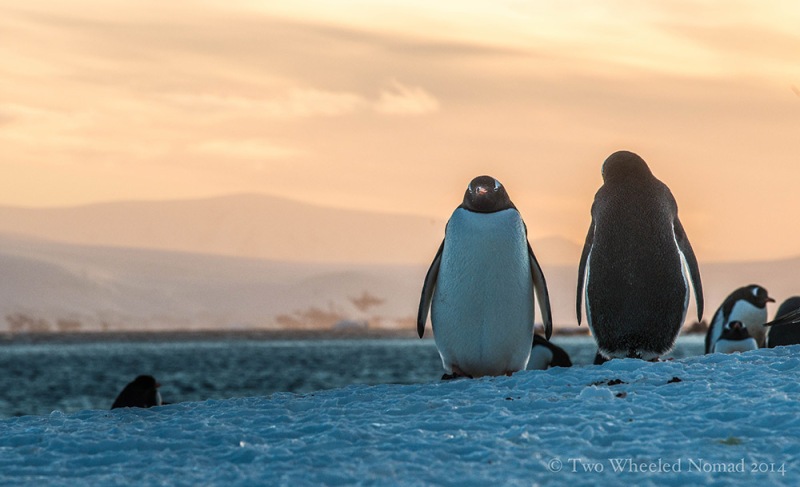
We set sail from the Beagle Channel leaving behind us views of the fjords past Puerto Williams, pushing ever south. Into the legendary Drake Passage we ventured, named after the pioneering Sir Francis himself. Potentially we could have run a course through a choppy crossing of strong winds thrashing turbulent waters. In preparing for the worst – gale-force weather is not exactly uncommon – we were rewarded with out-of-the-blue benign conditions.
We picked up no more than a four on the Beaufort Scale; 12 being synonymous with a hurricane. Relax Lisa, your sea legs have already kicked in from a previous lifetime at sea. With a swarm of wandering, black-browed and light mantled sooty albatross catching the updraft of our ship – dominating the scene in and around a cluster of cape petrels – I had to pinch myself we were really doing this. We were bound for the Antarctic! The last place on the Earth. The thought alone nearly knocked me sideways – grateful that the gentle boat sway didn’t.

As the coldest, windiest and driest continent, Antarctica is also the globe’s largest white desert wilderness. Surely the purest place on the planet. To reach it, one must cross the Antarctic Convergence. This is a curve continuously encircling Antarctica where cold, northward-flowing Antarctic waters meet the relatively warmer waters of the sub-Antarctic. More interestingly, mean temperatures in Antarctica’s interior plummet to -70 degrees Celsius where the record sits at an even chillier -92. That would be nippy on the knockers. Thermals? Check.
The Antarctic is a generic term for the Southern Polar region, everything south of latitude 66.5 degrees whereas Antarctica refers to the continental land mass in that region. Conceivably, Antarctica is home to 90 per cent of the world’s ice – the largest single piece of ice on Earth that’s up to 19 million square kilometres – and 70 per cent of all fresh water. Incredible when you think the world’s only other ice sheet in Greenland holds just a drop at nine per cent of the globe’s frozen water. The continental ice sheet averages around 2.5 kilometres in thickness where a mere quarter of one per cent isn’t glacial, visible as snow-smothered mountains and coastal features. ¡Ay, caramba!
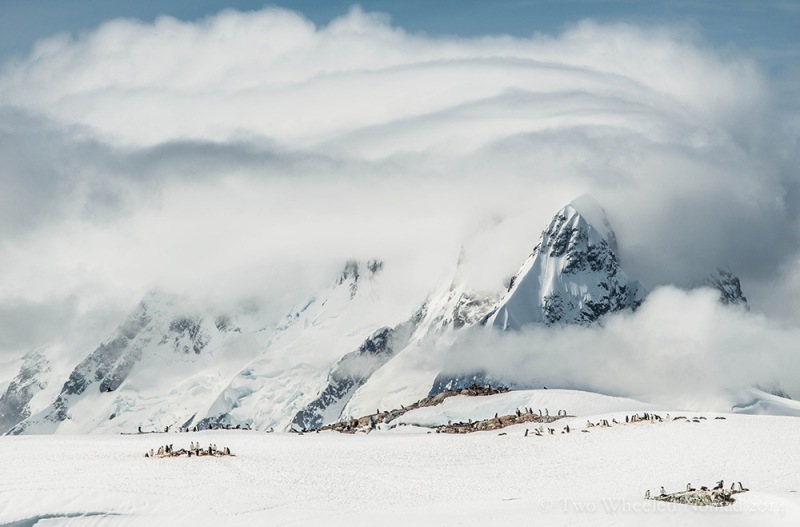
To set the scene on the seventh and final continent: Antarctica Peninsula is a long chain of alpine mountains, topped by an ice plateau and sculpted by countless active glaciers. Ice cliffs dominate the coastline where these gargantuan glaciers manage to carve their way through valleys or even override the ranges and eventually merge into the Ross Ice Shelf. It’s tricky to contemplate how inhospitable and exposed that would leave any wildlife wandering around. Marine and bird life, despite the odds, abounds in and on the seas surrounding Antarctica. Seals, penguins and various other species of birds are the only permanent residents – all of whom are from a higher ilk of ‘tough cookie’.
No sooner had our ship’s thrusters started whirling and guests were given an itinerary of back-to-back lectures from expert-in-their-field expedition staff. Marine biology, ornithology, the weather, geography, glaciology and geology, the environment and history headlined the daily agenda. Sitting in the lounge before an animated presenter and a big projector screen or viewing the same from the comfort of your cabin, simply by switching to channel 8, people appreciated the option to pick and choose. Others would give in and snooze in either location when unable to fight it any longer. Antarctic adventuring is more tiring than you think.
Alex, the expedition leader required all passengers to attend an IAATO (International Association of Antarctic Tour Operators) meeting about correct conduct on the white continent. It gave us a purity of purpose much bigger than ourselves. It was an adherence to conscience that made us acutely aware to all the precious variables at play within the still unspoiled environment. Consequently, we vacuumed our on-shore items, washed and sanitised the footwear and officially declared nothing other than memories and photographs would be taken. Fair enough.
Occasionally elusive and always enigmatic, Alex was also sea-green incorruptible, the fixed point on this voyage. The ultimate source of assistance, information and knowledge. Under present circumstances, his mental processes were fired to a white-hot pitch that would melt the walls. He seamlessly laced a dry humour through the necessary ‘Dos and don’ts’, exhibited a pin-sharp memory and a exuded calm like that of an ER surgeon. A rugged beard framed a moustache that curled up at the sides – matured his features without hiding a pair of bright, young eyes. I liked him instantly.

Day two of the crossing and circumstances had conspired to favour an early arrival: Deception Island, home to a horseshoe volcano, part of the South Shetland Islands. Staff jumped at the chance to have us hop into the zodiac, our 10-passenger rigid inflatable, ice-strengthened boat and make the first of three bonus ‘opportunistic’ landings. Wonderful weather on top, we were off to a winning start. We emerged from the ship into a cold, icy world at once unfamiliar and intoxicating. Jaw-on-the-floor, I just gazed. Overawed like never before. Bone-deep delight surfaced upon a scene of polar magnificence, far beyond the grandeur of the glossy promo literature. My face distorted into a rictus by the wonder – as the Irish would say, it was savage.

Dramatic grey-pink skies radiated deep into the evenings, striking sunsets would bowl me over as much as catch me out. The rays grazing the surface of sapphire waters were red, orange and yellow while illuminating mammoth icebergs, shimmering with a neon-bright luminescence. It’s like nothing we’d imagined nor could have imagined outside our experience to date. Including burning my chin between 9-10.30pm!
As the sun set at 9.30pm and rose around 3am, it was twilight throughout the night without ever getting close to pitch. Note to self: An unquestionably thinner ozone meant my no-melanin skin was absorbing UV light better than a sponge taking on water. Welcome to being a redhead in Antarctica. In doubting the credibility of my factor 50 sunscreen, and knowing the staff had previously gotten sunburned in fog, I took my glowing red chin and scooted down to the onboard shop. Shame, they didn’t stock SPF Antarctic.
Throughout the trip, we caught photo-worthy glimpses of humpbacks and killer whales as well as getting flashes of a dorsal fin, water-spurting blowhole or fluke on the odd minke and fin whales. The Antarctic isn’t referred to as ‘Citation Nation’ for nothing. Not a day passed without close-up sightings of penguins porpoising through the water. Sometimes only a few metres from our sea-kayaks while colonies of long-tailed gentoo, wing-spread Adélie or distinctive chinstrap penguins would bustle about in the bay. Spread-eagled Weddell seals appeared oblivious, harrumphed and snorted before falling back into a lazy siesta again. Some day dreamed, others snored deeply in the weak sun. All inside a white landscape of floating sea ice, giant cravasses and glowing blue ice structures. It decidedly set the tone of the trip.

By day three, colossal ice action was becoming our new norm; ripping away now and again from glaciers or a mass of scultped icebergs, which sparkled in the sun and fed further excitement through our already thrill-saturated veins. We took our first leisurely zodiac cruise around Cierva Cove, clocking the cormorants gliding above and putting a disinfected pair of wellies down onto the peninsula. Standing firmly on Antarctica. What a euphoric moment. I stared at the steady accumulation of frozen ice thickening on everything outside in air cold enough that our breath hung white around us.
The afternoon saw a playful, eddying wind off Portal Point that I never quite knew which way was blowing. Both the penguins and Jason undertook a little porpoising. With a protruding tongue-tip that imparted a look of great concentration, Jason accidentally capsized from his kayak into the drink. Cue the copied penguin swimming. “Unintentional swimmer! Unintentional swimmer!” the rest of the pointing well-briefed kayakers boomed, while I nearly fell in backwards off the zodiac laughing too hard. Some overly-enthusiastic skulling there Jase?
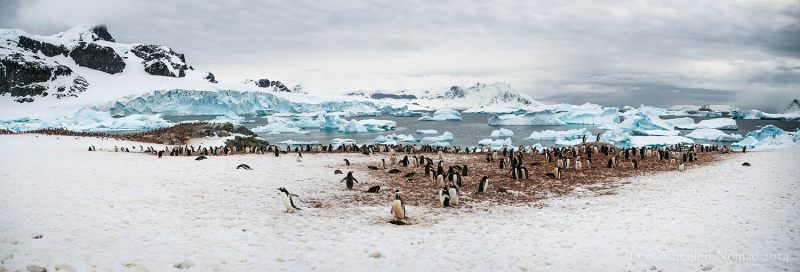
Orne Harbour was as labour-intensive as the trip was going to get. Floraine, a Swedish girl I gelled with on board and I night-hiked up a mountain, running up like crazed mountain goats to bleed off some excess energy. Feeling giddy all the way up for no other reason than where we were. And the company we were keeping. It always feels good to be amongst contagiously happy people. The high vantage point showed us a speck more of what a great expanse of white empty nothingness the place really was. We saw just a tip of the iceberg! Everything was abandoned to the cold and ice, yet surviving the most brutal conditions on Earth all around us were the penguins and birds. I’ll never complain that I’m cold again.
Cuverville Island was a small island dominated by a large, lichen-covered rocky outcrop. The morning saw a substantial rookery of gentoos coming and going about their business. Lots of mating action to be had there if not already underway. Was it wrong to want to witness the intimate ritual? A fascinating display of talking to one another, bowing genteelly in courtship as only gentoos can and wasting not a second more in getting on with the deed itself. Harmonious.
And so a plethora of persistent males wooed the females. Apathy arose when the odd female would reject a male. It was curious to watch the males shrug off the rebuff and try elsewhere to achieve their personal aspirations that day. More curious perhaps when the dismissing female clocked the consequences of her actions and shuffled after Mr Rejectee having changed her mind. “Sorry love, you’re too late – I’m with Martia now. Chau babe”, he squawked with a certain frisson of satisfaction.
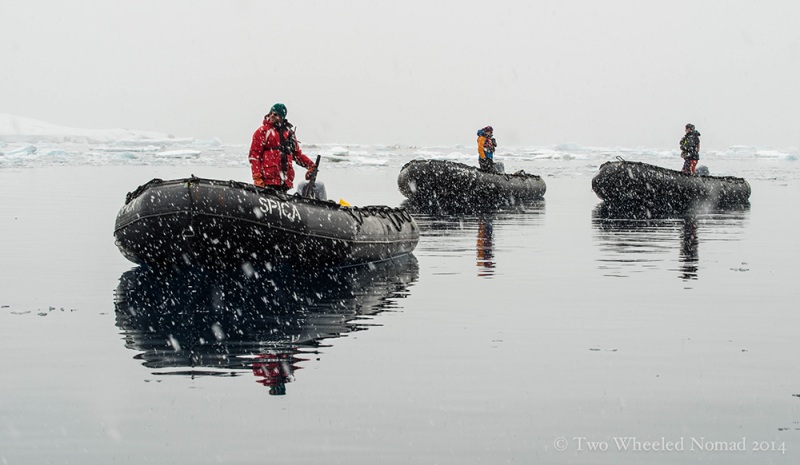
Outgrown all those behaviours, penguin mothers would attentively tend to their eggs while a predatory bird known as the skewer would permanently sniff out any eggs left momentarily unsupervised. Observing a skewer steal one on the sly to feed its own chick was one thing, but to have to watch the resultant penguin’s forlorn and lost reaction leaves you powerless. My heart instantly tried to climb up to my throat like a rat up a drainpipe.
Neko Harbour gave us prime opportunity to hit the water in the kayaks once again. Named after the floating whale factory ship, Neko is home to approximately 250 breeding pairs of penguins but infamous for its calving glaciers. A startling video shown on board beforehand made me sit up and pay attention showing the impact of a hefty calving. Think tsunami and then visualise flipping zodiac boats, kayaks capsizing and penguins running for their lives. That’d up the ante in our video footage.
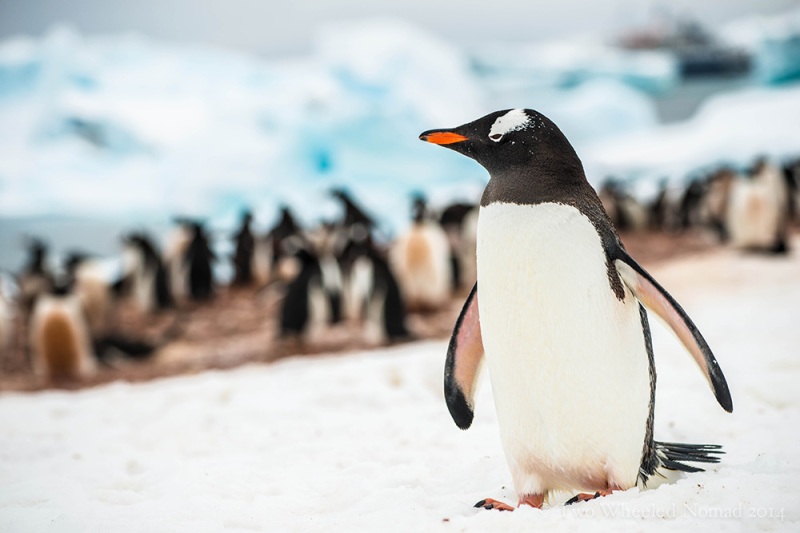
For us at Neko, what started with the penguins casually swimming alongside us and some small chunks of ice rumbling down into the sea turned into nothing more than a strong headwind and strenuous paddle back. Personally, I’d have preferred riding the wake from an over-zealous carving. Turning my back to a breath-snatching wind, I tried to ignore the frigid air brushing my neck and taking possession of my toes. Alas we started to make our circuitous way home. Cold was creeping quickly through my drysuit and base layers. There was an attending chill that fought to take my breath away and I groaned like someone much older. Eventually back on board after the best part of three hours, my half frozen fingers responded with about as much dexterity as oversized clubs at the end of my arms. What did I expect in the Antarctic?
Next up, The Lemaire Channel. The Russian captain’s biggest challenge navigating us through an 800-metre wall-to-wall narrow crossing for 11 kilometres; negotiating towering peaks overhead and a sea surface smothered in densely packed ice. Very otherworldly, it no longer felt remotely familiar to anything else on Earth. The ship’s course was further choked by an imposing display of large tabular bergs, bunched together the way sky scrapers loom over New York.
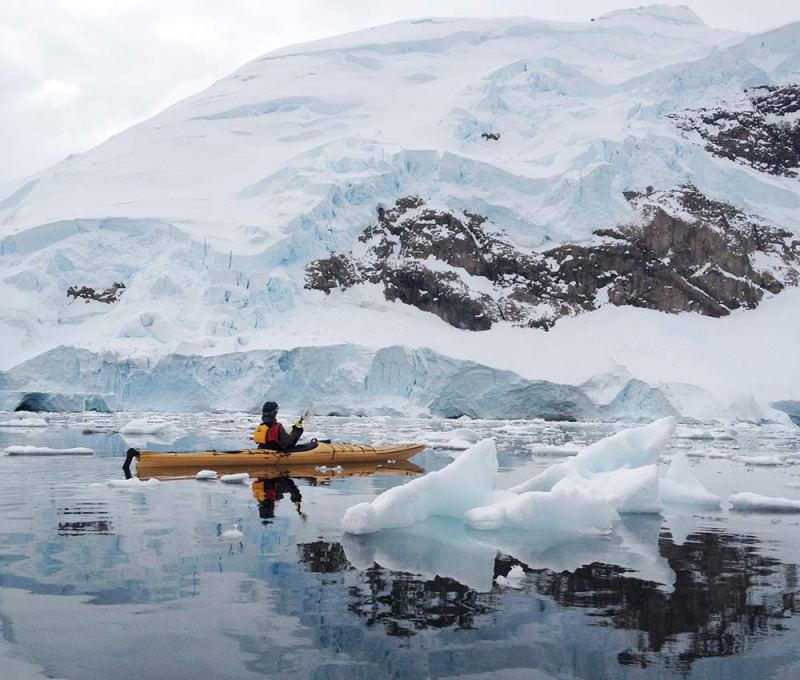
Making it to Petermann Island was a sight to behold. Our most southerly point on the voyage. Having taken its name from a German geographer and supporter of polar exploration, the island is home to 300 breeding pairs of Adélies and the most southerly colony of gentoos in Antarctica at around 2,000 breeding pairs. That’s a pungent amount of penguin poop. The sun on Petermann peaked at the trip’s highest temperature, perhaps tipping into double figures. Perched on a rock our eyes were glued to a wide ice structure akin to a bouncy castle gently pitching and rolling in the water. It was like watching an arcade’s two pence slot machine stacked with coins, edge closer off its moving tray. The ice didn’t break but I guess as far as the jackpot was concerned, we’d already won that the moment we stepped onto an Antarctic-bound boat.

Glancing around Petermann Island, the snow petrels patrolled the Antarctic-cool skies. Blue-eyed shags would come and go, feeding their chicks. Some of the penguins took to tobogganing on their chests for ease and speed of travel while others tootled up their highways heading to Gentoo Road, Adélie Alley or Chinstrap City. All in the name of nest-building, diligently fetching materials to construct their safe-havens, high up out of harm’s way. If you’re a penguin you might as well build your nest with panoramic views. Hard going on their hard-working but happy feet though. Such purposeful little creatures, I studied them for hours. A tidal wave of excitement rolled over me that then just as quickly mutated into a smile erupting on my face. This was my new happy place.
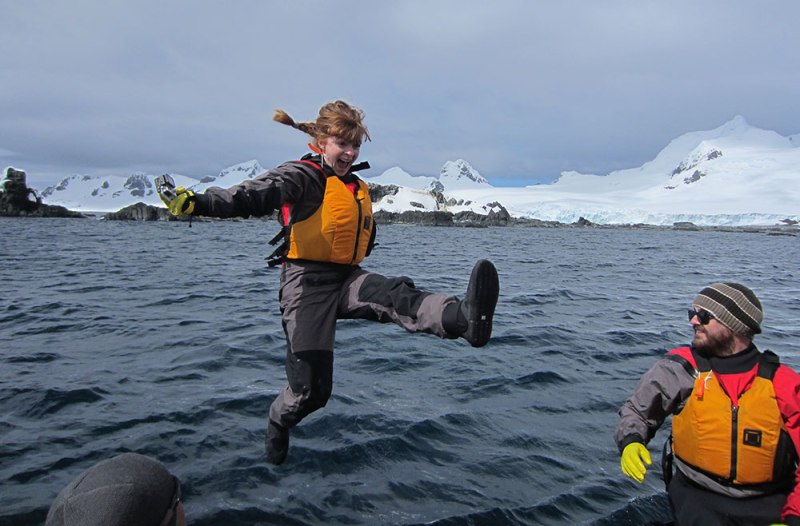
Having visited a Ukraine station, passed several Argentinean ones it was time to head to a British base. The Ukraine’s Vernadsky station was sold by the Britons for the nominal price of a pound back in 1996, as it was cheaper for them to sell up than pay to remove the buildings. Incidentally Vernadsky was where scientists first observed depletion in the ozone layer, known as the ozone hole. That’ll burn more than just your chin at 10pm without the right precautions. The Ukrainians seemed pretty pleased to receive us, their first set of guests since March. Willingly, they opened up the bar hoping for a roaring trade by sharing their homemade vodka. $3 a pop or a shot in exchange for a lady’s bra no less. What’s the secret ingredient then lads, distilled penguin? It tickled me in discovering a batch of wood was previously handed over to the site staff with a brief to build a jetty. Destiny had other ideas that day, at least the minds of three Ukrainian guys did when they opted to erect a bar instead. Sadly they got the sack but a fine example of ingenuity boys!
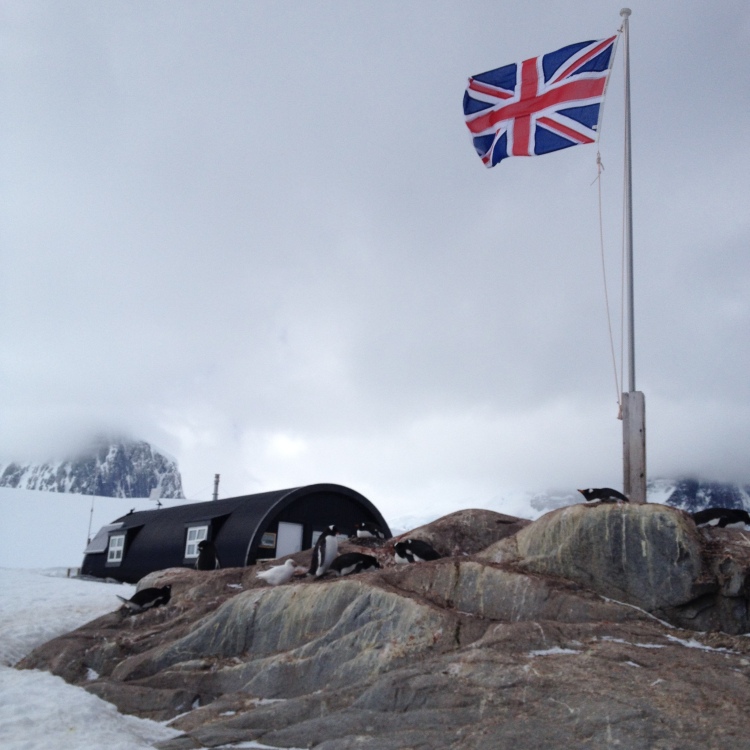
Port Lockroy was the name given to the British Antarctic Survey. A good vantage point to cast your eyes over Snow White and the Seven Dwarfs, a fairytale-esque set of mountains featuring prominently on the icescape. A delightful little museum depicting life on the Antarctic in the ‘50s, including rusting cans of food on exhibit, an amply stocked gift shop and the Penguin Post Office were the highlights of our visit. I chatted to the base’s staff in the time we’d been allotted: a bubbly Scottish girl with wild curly hair as red as new copper and a forthcoming English guy with connections to Nottingham. It was nostalgic to swop some stories of home sweet home.
If the glacial temperatures of the Antarctic weren’t quite racy enough for you, the staff offered a ‘Polar Plunge’. Whether donning your bikini, budgie-smugglers or bathers, the idea of voluntarily jumping in for a head-to-toe dip seemed to hit a new level of crazy. My thought process rapidly established some mental balance: Tempting…but no. The ‘before’ and ‘after’ expressions were priceless on the 35 folks that opted in. Comedy gold mingled with just a hint of Schadenfreude – guys, you had my full respect. I felt only a tenth of their pain when volunteering to become an ‘intentional swimmer’, albeit in a drysuit. A mentalist I am not. In water less than one degree, I fully submerged and laughed hysterically in the watery process. Should’ve gone the whole hog!
Half Moon Island featured next on the itinerary; another supreme site for sea-kayaking. A prime location for penguins to amble across pebbled beaches too, beavering away at the construction of their homes. While whales occasionally spy-hopped, meaning they would poke out of the water ‘nose up’ for a stealthy peek at their prey, Antarctic terns dive-bombed for a quick bite to eat. The mountainside was a frozen region of towering ice with steep, jagged peaks. Some shed cold tears as they trickled down the ice face while my fingers marched a slow exploration of the sea ice, bobbing alongside us; exquisitely scalloped all over where waves and wind had intervened and left their design of existence. An audible and continuous ‘snap, crackle and pop’ diverted my attention away from anything else. I paused to take in the beauty of a world engulfed in crystal. Everything reflected light and contributed to the heightened brilliance of the late afternoon. I will sorely miss this place.
The Antarctic is steeped in as much ice as uniqueness. Nothing there but silence, blessed and profound. Icebergs stand off-centre in a lush white scene encircled by midnight-blue ocean. The place effortlessly achieves a state of otherworldliness and in being there, it almost feels like your physical form transcends its corporeal limitations to escape the very bonds of Earth. It’s from time immemorial where light bursts forth in dazzling profusion. One of the farthest ends of the planet yet such a serene but dramatic space. I, as much as everyone else pray we never tame it. Stepping into what feels like a painting more oft than not, the surrealism takes hold with such intensity, it’s overwhelming on the emotions. And it will leave your image-tank more than full. Someone asked me during the trip, “Dear, are you enjoying the Antarctic?” Stunned to the root of my soul, I just welled up, smiled with a nod and swallowed hard. Beyond incredible.

Icy trails and penguin tails – by Lisa Morris
Having embarked the ‘Sea Adventurer’ with no expectation,
Within hours, we were bestowed a visual sensation.
Favourable seas teemed with wildlife,
Gliding on the Drake, bewitching birds were rife.
Antarctic terns, cape petrels and the masterful albatross,
Swirling above, their paths would majestically cross.
I marvelled at their movement – the Titans of the Sky,
All of whose soaring displays for my attention they would vie.
I glimpsed a pod of humpbacks breaching,
And watched the mother’s calf take mindful note in the teaching.
Penguins, penguins, penguins! Ahoy!
Bustling colonies of gentoo, chinstrap and Adélie – oh boy.
Porpoising to the water’s edge to assume a ‘waddle come shuffle’,
These highway-bound creatures were so purposeful.
Was it a perpetual vigilance against the sly old skewer?
Nature takes penguins’ eggs for good reason but still leaves them fewer.
My soul sang upon sightings of minke, fin and killer whale,
This seafaring expedition was leagues from a fail.
Glacier-studded mountains towered over Antarctica’s glistening icescape,
Eyes feasted on colossal ice action as carvings made a striking escape.
When polar grandeur mingles with an overwhelming calm, it surfaces euphoric delight,
Especially when steely grey skies play and tease the light.
Snow-smothered peaks create a serene but dramatic environment,
Leaving every nerve atingle in this otherworldly continent.
In a place that’s steeped in as much history as snow,
A fellow passenger enquired, “Dear, are you enjoying the show?”
I swallowed hard and nodded with a smile,
Quark Expeditions had gone fathoms deeper than the extra mile.